Evolution of a Late Carboniferous Fluvio-Lacustrine System in an Endorheic Basin: Multiproxy Insights from the Ludwikowice Formation, Intra-Sudetic Basin (SW Poland, NE Bohemian Massif)
Abstract
1. Introduction
2. Geological Setting
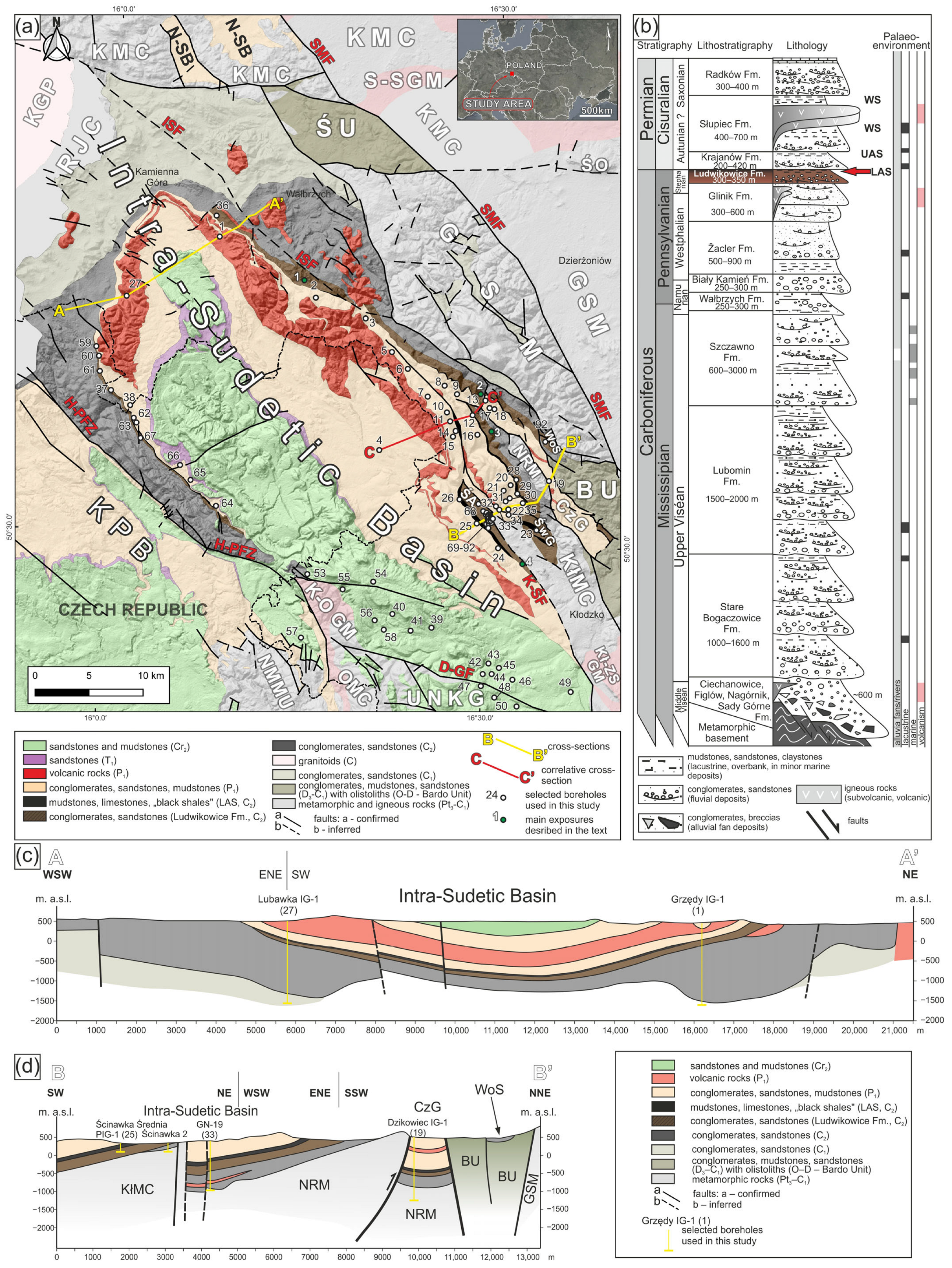
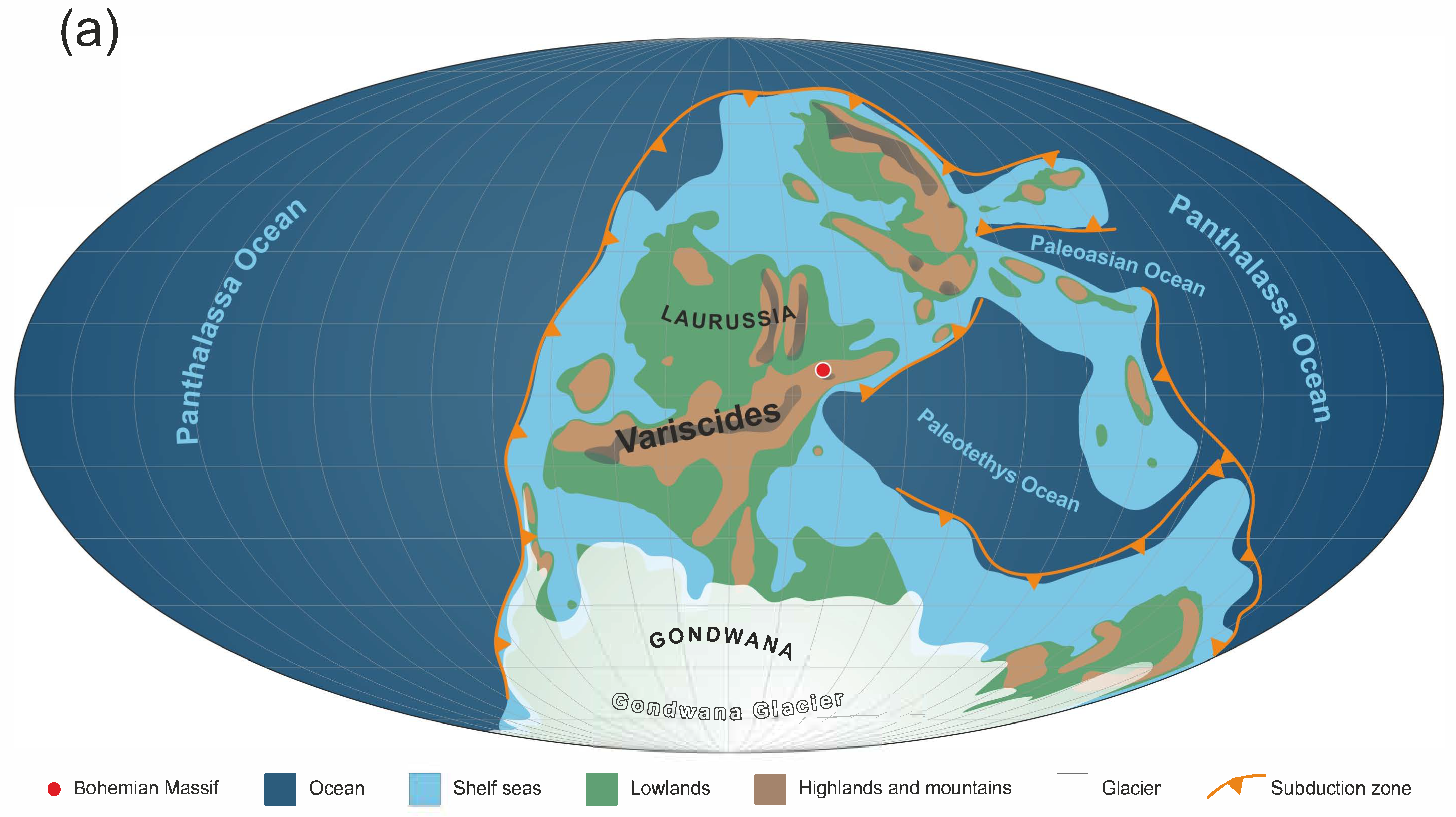
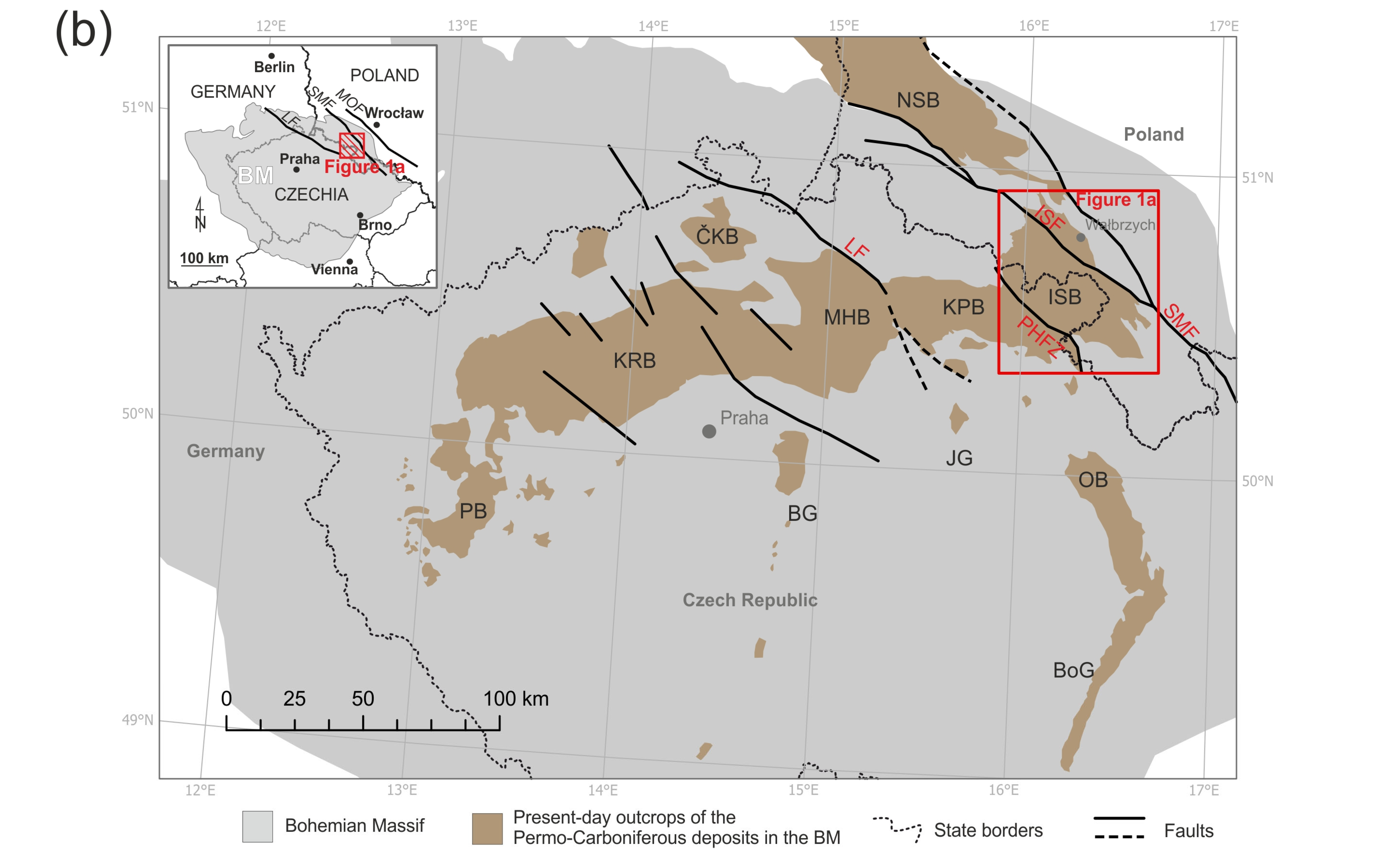
3. Dataset and Methods
3.1. Borehole and Surface Data
3.2. Core Descripton and Lithofacies Analysis
3.3. Petrography
3.4. Inorganic Geochemistry/Carbonate Content and Isotopic Composition
3.5. Magnetic Susceptibility
3.6. Organic Petrology
3.7. Palynology
4. Results
4.1. Extent and Thickness of the Ludwikowice Formation
4.2. Lithofacies and Facies Associations
4.2.1. Fluvial Facies Association (FA1)
4.2.2. Sandy to Muddy Floodplain Facies Association (FA2)
4.2.3. Aeolian Facies Association (FA3)
4.2.4. Playa Lake Margin/Coastal Mudflat Facies Association (FA4)
4.2.5. Nearshore Facies Association (FA5)
4.2.6. Delta Plain Facies Association (FA6)
4.2.7. Subaqueous Delta Front and Subaqueous Fan Facies Association (FA7)
4.2.8. Prodelta Facies Association (FA8)
4.2.9. Open Lake Facies Association (FA9)
4.3. Inorganic Geochemistry and Magnetic Susceptibility
4.4. Bulk Carbonate Isotopic Composition
4.5. Organic Petrography
Macerals
4.6. Thermal Maturity Assessment
4.7. Palynofacies and Sporomorph Assemblages
5. Interpretation and Discussion
5.1. Inorganic Geochemical and Magnetic Susceptibility Signatures in Fluvio-Lacustrine System Dynamics
5.2. Organic Matter Composition and Palynomorphs
5.2.1. Bituminous Association (BA)
5.2.2. Humic Association (HA)
5.2.3. Intermediate Association (IA)
5.3. The Ludwikowice Formation: Depositional Models and Controls on the Late Carboniferous Fluvio-Lacustrine System in the Intra-Sudetic Basin
5.4. Late Carboniferous Palaeogeography of the Intra-Sudetic Basin
6. Conclusions
- (1)
- The Ludwikowice Formation constitutes a latest Carboniferous (late Gzhelian) fining-upward megacyclothem in the fault-controlled intramontane Intra-Sudetic Basin (NE Bohemian Massif, SW Poland) that records a transition from proximal, coarse-grained fluvial deposits to distal, fine-grained, organic-rich lacustrine facies, collectively referred to as the Lower Anthracosia Shale (LAS).
- (2)
- The formation displays pronounced lateral thickness variability, generally thickening from the east, northeast, and southeast toward central–eastern depocenters aligned NW–SE along the Intra-Sudetic and Krajanów–Ścinawka faults. It typically overlies the fluvial Glinik Formation but locally rests directly on metamorphic basement in the south. Maximum thickness exceeds 600 m near Nowa Ruda, while it thins to approximately 50–100 m along the western basin margin (east of the Hronov–Poříčí Fault and the Lubawka–Czech sector) and is entirely absent in the southernmost part of the basin. The Lower Anthracosia Shale exhibits a similar distribution pattern, reaching up to ~135 m in the Nowa Ruda area and thinning westward to ~5–10 m in distal western sectors. Coarse-grained facies diminish toward the basin interior, though localized coarse aprons are developed in the northeastern (up to ~90% of the succession), eastern and southern sectors of the basin.
- (3)
- The nine lithofacies associations (FA1–FA9) identified within the Ludwikowice Formation represent a late Carboniferous fluvio-lacustrine depositional system of the Intra-Sudetic Basin. These include fluvial (FA1), sandy to muddy floodplain (FA2), aeolian (FA3), playa lake margin/coastal mudflat (FA4), nearshore (FA5), delta plain (FA6), subaqueous delta front and subaqueous fan (FA7), prodelta (FA8), and open lake (FA9) deposits. Collectively, they document a four-stage evolution from proximal, high-energy fluvial and alluvial environments (FA1), through transitional floodplain and lake-margin settings (FA2–FA6), to distal lacustrine conditions (FA7–FA9), and finally a return to fluvial sedimentation (FA1). The facies architecture and stratigraphic stacking broadly conform to the typical depositional evolution of extensional rift basins, particularly those that developed in equatorial Pangea after the Variscan orogeny.
- (4)
- Geochemical, isotopic, and petrological data support the interpretation of evolving redox and hydrological regimes within the basin. Carbon and oxygen isotope compositions from lacustrine carbonates show intervals of both correlated and uncorrelated behavior, suggesting alternating phases of hydrologically open and closed lake conditions. These patterns, together with Si/Al and Fe/Mn ratios, indicate changes in freshwater influx, evaporative concentration, and nutrient supply. Magnetic susceptibility data further support variations in detrital input and microbial magnetite formation, pointing to climatic oscillations between wetter and more arid phases. The coupling of sedimentological and geochemical proxies allows for a detailed reconstruction of basin dynamics and lake-level changes.
- (5)
- The composition and distribution of organic matter reveal three distinct petrographic associations: bituminous, humic, and intermediate, each reflecting specific environmental conditions. Bituminite- and alginite-rich intervals correspond to deepwater, anoxic depositional settings with high aquatic productivity and minimal clastic dilution, while humic associations dominated by vitrinite with smaller sporinite content represent more oxygenated, higher-energy conditions with substantial terrestrial input. These associations correlate well with interpreted lithofacies, maceral assemblages and palynofacies types, confirming a strong linkage between organic matter preservation, redox gradients, and depositional subenvironments.
- (6)
- Altogether, the Ludwikowice Formation provides a well-preserved archive of late Carboniferous paleoenvironmental change within a tectonically active continental basin. Its vertical organization and internal facies variability reflect a sensitive response to both allogenic (tectonic and climatic) and autogenic (depositional) controls. The results presented in this study offer new insights into the processes governing fluvio-lacustrine sedimentation in intramontane (endorheic) basins and contribute to broader models of basin evolution, lake dynamics, and organic matter accumulation during the Late Paleozoic.
Supplementary Materials
Author Contributions
Funding
Data Availability Statement
Acknowledgments
Conflicts of Interest
Abbreviations
| ISB | Intra-Sudetic Basin |
| GSM | Góry Sowie Massif |
| LAS | Lower Anthracosia Shale |
References
- Ezquerro, L.; Liesa, C.L.; Simón, J.L.; Luzón, A. Sequence stratigraphy in continental endorheic basins: New contributions from the case of the northern extensional Teruel Basin. Sediment. Geol. 2025, 481, 106868. [Google Scholar] [CrossRef]
- Marenssi, S.A.; Limarino, C.O.; Schencman, L.J.; Ciccioli, P.L. Tectonic and geomorphic controls on the lacustrine deposits of the Neogene Vinchina Basin, northwestern Argentina. J. Sediment. Res. 2020, 90, 250–267. [Google Scholar] [CrossRef]
- Ciccioli, P.L.; Marenssi, S.A.; Amidon, W.H.; Limarino, C.O.; Kylander-Clark, A. Alluvial to lacustrine sedimentation in an endorheic basin during the Mio-Pliocene: The Toro Negro Formation, central Andes of Argentina. J. South Am. Earth Sci. 2018, 84, 69–87. [Google Scholar] [CrossRef]
- Garcia-Castellanos, D. Long-term evolution of tectonic lakes: Climatic controls on the development of internally drained basins. In Tectonics, Climate, and Landscape Evolution; Geological Society of America: Boulder, CO, USA, 2006; ISBN 978-0-8137-2398-3. [Google Scholar]
- Ventra, D.; Nichols, G.J. Autogenic dynamics of alluvial fans in endorheic basins: Outcrop examples and stratigraphic significance. Sedimentology 2014, 61, 767–791. [Google Scholar] [CrossRef]
- Carroll, A.R.; Bohacs, K.M. Stratigraphic classification of ancient lakes: Balancing tectonic and climatic controls. Geology 1999, 27, 99–102. [Google Scholar] [CrossRef]
- Nichols, G. Fluvial Systems in Desiccating Endorheic Basins. In Sedimentary Processes, Environments and Basins; Nichols, G., Williams, E., Paola, C., Eds.; Wiley: Hoboken, NJ, USA, 2007; pp. 569–589. ISBN 978-1-4051-7922-5. [Google Scholar] [CrossRef]
- Nichols, G. Endorheic Basins. In Tectonics of Sedimentary Basins; Busby, C., Azor, A., Eds.; Wiley: Hoboken, NJ, USA, 2011; pp. 621–632. ISBN 978-1-4051-9465-5. [Google Scholar] [CrossRef]
- Yapiyev, V.; Sagintayev, Z.; Inglezakis, V.; Samarkhanov, K.; Verhoef, A. Essentials of Endorheic Basins and Lakes: A Review in the Context of Current and Future Water Resource Management and Mitigation Activities in Central Asia. Water 2017, 9, 798. [Google Scholar] [CrossRef]
- Andrews, S.D.; Hartley, A.J. The response of lake margin sedimentary systems to climatically driven lake level fluctuations: Middle Devonian, Orcadian Basin, Scotland. Sedimentology 2015, 62, 1693–1716. [Google Scholar] [CrossRef]
- Folkestad, A.; Steel, R.J. The alluvial cyclicity in hornelen basin (Devonian Western Norway) revisited: A multiparameter sedimentary analysis and stratigraphic implications. In Norwegian Petroleum Society Special Publications; Elsevier: Amsterdam, The Netherlands, 2001; Volume 10, pp. 39–50. [Google Scholar] [CrossRef]
- Andrews, S.D.; Guo, L. Mixed clastic-carbonate lake margin systems: An example from the Triassic of East Greenland. Depos. Rec. 2025, 11, 675–697. [Google Scholar] [CrossRef]
- Olsen, P.E.; Kent, D.V.; Cornet, B.; Witte, W.K.; Schlische, R.W. High-Resolution Stratigraphy of the Newark Rift Basin (Early Mesozoic, Eastern North America). Geol. Soc. Am. Bull. 1996, 108, 40–77. [Google Scholar] [CrossRef]
- Donaghy, E.E.; Umhoefer, P.J.; Eddy, M.P.; Miller, R.B.; LaCasse, T. Stratigraphy, age, and provenance of the Eocene Chumstick basin, Washington Cascades; implications for paleogeography, regional tectonics, and development of strike-slip basins. GSA Bull. 2021, 133, 2418–2438. [Google Scholar] [CrossRef]
- Nichols, G.J.; Hirst, J.P. Alluvial fans and fluvial distributary systems, Oligo-Miocene, northern Spain; contrasting processes and products. J. Sediment. Res. 1998, 68, 879–889. [Google Scholar] [CrossRef]
- Crowell, J.C. Introduction to geology of Ridge Basin, southern California. In Evolution of Ridge Basin, Southern California: An Interplay of Sedimentation and Tectonics; Geological Society of America: Boulder, CO, USA, 2003; ISBN 978-0-8137-2367-9. [Google Scholar]
- Bohacs, K.; Carroll, A.; Neal, J.; Mankiewicz, P. Lake-basin type, source potential, and hydrocarbon character: An integrated sequence-stratigraphic–geochemical framework. In Lake Basins Through Space and Time; AAPG Studies in Geology: Tulsa, OK, USA, 2000; Volume 46, pp. 3–33. [Google Scholar]
- Benavente, C.A.; Bohacs, K.M. Advances in limnogeology: The lake-basin-type model revisited 25 years after… anomalies, conundrums and upgrades. Depos. Rec. 2024, 10, 748–792. [Google Scholar] [CrossRef]
- Tourtelot, H.A. Black shale—Its deposition and diagenesis. Clays Clay Miner. 1979, 27, 313–321. [Google Scholar] [CrossRef]
- Kruge, M.A.; Hubert, J.F.; Jay Akes, R.; Meriney, P.E. Biological markers in Lower Jurassic synrift lacustrine black shales, Hartford Basin, Connecticut, U.S.A. Org. Geochem. 1990, 15, 281–289. [Google Scholar] [CrossRef]
- Martínek, K.; Blecha, M.; Daněk, V.; Franců, J.; Hladíková, J.; Johnová, R.; Uličný, D. Record of palaeoenvironmental changes in a Lower Permian organic-rich lacustrine succession: Integrated sedimentological and geochemical study of the Rudník Member, Krkonoše Piedmont Basin, Czech Republic. Palaeogeogr. Palaeoclimatol. Palaeoecol. 2006, 230, 85–128. [Google Scholar] [CrossRef]
- Liu, B.; Lü, Y.; Meng, Y.; Li, X.; Guo, X.; Ma, Q.; Zhao, W. Petrologic characteristics and genetic model of lacustrine lamellar fine-grained rock and its significance for shale oil exploration: A case study of Permian Lucaogou Formation in Malang Sag, Santanghu Basin, NW China. Pet. Explor. Dev. 2015, 42, 656–666. [Google Scholar] [CrossRef]
- Sun, N.; He, W.; Zhong, J.; Gao, J.; Sheng, P. Lithofacies and shale oil potential of fine-grained sedimentary rocks in lacustrine basin (Upper Cretaceous Qingshankou Formation, Songliao Basin, northeast China). Minerals 2023, 13, 385. [Google Scholar] [CrossRef]
- Wang, M.; Xue, H.; Tian, S.; Wilkins, R.W.T.; Wang, Z. Fractal characteristics of Upper Cretaceous lacustrine shale from the Songliao Basin, NE China. Mar. Pet. Geol. 2015, 67, 144–153. [Google Scholar] [CrossRef]
- Zou, C.; Zhu, R.; Chen, Z.-Q.; Ogg, J.G.; Wu, S.; Dong, D.; Qiu, Z.; Wang, Y.; Wang, L.; Lin, S.; et al. Organic-matter-rich shales of China. Earth-Sci. Rev. 2019, 189, 51–78. [Google Scholar] [CrossRef]
- Zhang, K.; Liu, R.; Liu, Z.; Li, L.; Wu, X.; Zhao, K. Influence of palaeoclimate and hydrothermal activity on organic matter accumulation in lacustrine black shales from the Lower Cretaceous Bayingebi Formation of the Yin’e Basin, China. Palaeogeogr. Palaeoclimatol. Palaeoecol. 2020, 560, 110007. [Google Scholar] [CrossRef]
- Fisher, J.A.; Nichols, G.J. Interpreting the stratigraphic architecture of fluvial systems in internally drained basins. J. Geol. Soc. 2013, 170, 57–65. [Google Scholar] [CrossRef]
- Nichols, G.J.; Fisher, J.A. Processes, facies and architecture of fluvial distributary system deposits. Sediment. Geol. 2007, 195, 75–90. [Google Scholar] [CrossRef]
- Weissmann, G.S.; Hartley, A.J.; Nichols, G.J.; Scuderi, L.A.; Olson, M.; Buehler, H.; Banteah, R. Fluvial form in modern continental sedimentary basins: Distributive fluvial systems. Geology 2010, 38, 39–42. [Google Scholar] [CrossRef]
- Hartley, A.J.; Weissmann, G.S.; Nichols, G.J.; Warwick, G.L. Large Distributive Fluvial Systems: Characteristics, Distribution, and Controls on Development. J. Sediment. Res. 2010, 80, 167–183. [Google Scholar] [CrossRef]
- Davidson, S.K.; Hartley, A.J.; Weissmann, G.S.; Nichols, G.J.; Scuderi, L.A. Geomorphic elements on modern distributive fluvial systems. Geomorphology 2013, 180–181, 82–95. [Google Scholar] [CrossRef]
- Weissmann, G.S.; Hartley, A.J.; Scuderi, L.A.; Nichols, G.J.; Davidson, S.K.; Owen, A.; Atchley, S.C.; Bhattacharyya, P.; Chakraborty, T.; Ghosh, P.; et al. Prograding Distributive Fluvial Systems—Geomorphic Models and Ancient Examples. In New Frontiers in Paleopedology and Terrestrial Paleoclimatology: Paleosols and Soil Surface Analog Systems; Driese, S.G., Nordt, L.C., Eds.; SEPM (Society for Sedimentary Geology): Broken Arrow, OK, USA, 2013; pp. 131–147. ISBN 978-1-56576-322-7. [Google Scholar]
- Moscariello, A. Alluvial fans and fluvial fans at the margins of continental sedimentary basins: Geomorphic and sedimentological distinction for geo-energy exploration and development. Geol. Soc. Lond. Spec. Publ. 2018, 440, 215–243. [Google Scholar] [CrossRef]
- Carraro, D.; Ventra, D.; Moscariello, A. Anatomy of a fluvial paleo-fan: Sedimentological and architectural trends of the Paleocene–Eocene Wasatch–Colton System (western Uinta Basin, Utah, U.S.A.). J. Sediment. Res. 2023, 93, 370–412. [Google Scholar] [CrossRef]
- Nemec, W.; Porębski, S.J.; Teisseyre, A.K. Explanatory notes to the lithotectonic molasse profile of the Intra-Sudetic Basin, Polish part (Sudety Mts., Carboniferous–Permian). In Tectonic Regime of Molasse Epochs; Schwab, G., Ed.; Veröff. Zentralinst. Erde: Potsdam, German, 1982; pp. 267–278. [Google Scholar]
- Lorenc, S. Rozprzestrzenienie, litologia i orientacyjne cechy geochemiczne czarnych łupków Sudetów (Distribution, lithology and approximate geochemical features of the Sudetes black shales). Prace Geologiczno-Mineralogiczne. Z badań nad mineralizacją rudną regionu sudeckiego 1993, 33, 179–208, (In Polish with English Summary). [Google Scholar]
- Yawanarajah, S.R.; Kruge, M.A.; Mastalerz, M.; Sliwinski, W. Organic geochemistry of Permian organic-rich sediments from the Sudetes area, SW Poland. Org. Geochem. 1993, 20, 267–281. [Google Scholar] [CrossRef]
- Nowak, G. Microscopic identification and classification of organic matter of the Upper Carboniferous Anthracosia Shales, Intra-Sudetic Depression, southwestern Poland. Geol. Q. 1998, 42, 41–58. [Google Scholar]
- Nowak, G.J. Comparative studies of organic matter petrography of the late Palaeozoic black shales from southwestern Poland. Int. J. Coal Geol. 2007, 71, 568–585. [Google Scholar] [CrossRef]
- Wójcik-Tabol, P.; Dąbek, J.; Nowak, G. Wstępna charakterystyka mineralogiczna czarnych łupków antrakozjowych z obszaru synklinorium śródsudeckiego (Preliminary mineralogical characteristics of the Anthracosia Shales from the Intra-Sudetic Synclinorium). Przegląd Geol. 2021, 69, 389–392, (In Polish with English Summary). [Google Scholar] [CrossRef]
- Nowak, G.; Górecka-Nowak, A.; Karcz, P. Petrographic, palynological and geochemical recognition of dispersed organic matter in the black Anthracosia Shales (Sudetes, South-West Poland). Geol. Q. 2022, 66, 36. [Google Scholar] [CrossRef]
- Dąbek-Głowacka, J.; Wójcik-Tabol, P.; Nowak, G.; Wendorff-Belon, M.; Marynowski, L. Łupki antrakozjowe niecki śródsudeckiej w świetle wskaźników geochemii organicznej—Wstępne wyniki analizy bituminów (The Anthracosia Shales from the Intra-Sudetic Basin in the light of organic geochemistry proxies—Preliminary results of bitumen study). Przegląd Geol. 2023, 71, 269–273, (In Polish with English Summary). [Google Scholar] [CrossRef]
- Dąbek-Głowacka, J.; Wójcik-Tabol, P.; Nowak, G.J. Influence of late Carboniferous–early Permian climate change on the sedimentary evolution: A case study of the lacustrine Lower Anthracosia Shales (Intra-Sudetic Basin, SW Poland). Geol. Q. 2024, 68, 5. [Google Scholar] [CrossRef]
- Franke, W.; Żelaźniewicz, A. Variscan evolution of the Bohemian Massif (Central Europe): Fiction, facts and mroblems. Gondwana Res. 2023, 124, 351–377. [Google Scholar] [CrossRef]
- Catalán, J.R.M.; Schulmann, K.; Ghienne, J.-F. The Mid-Variscan Allochthon: Keys from correlation, partial retrodeformation and plate-tectonic reconstruction to unlock the geometry of a non-cylindrical belt. Earth-Sci. Rev. 2021, 220, 103700. [Google Scholar] [CrossRef]
- Mazur, S.; Aleksandrowski, P.; Kryza, R.; Oberc-Dziedzic, T. The Variscan Orogen in Poland. Geol. Q. 2006, 50, 89–118. [Google Scholar]
- Aleksandrowski, P.; Kryza, R.; Mazur, S.; Pin, C.; Zalasiewicz, J.A. The Polish Sudetes: Caledonian or Variscan? Trans. R. Soc. Edinb. Earth Sci. 1999, 90, 127–146. [Google Scholar] [CrossRef]
- Cháb, J.; Breiter, K.; Fatka, O.; Hladil, J.; Kalvoda, J.; Šimůnek, Z.; Štorch, P.; Vašíček, Z.; Zajíc, J.; Zapletal, J. Outline of the Geology of the Bohemian Massif: The Basement Rocks and Their Carboniferous and Permian Cover; Czech Geological Survey: Prague, Czech Republic, 2010.
- Opluštil, S.; Šimůnek, Z.; Zajíc, J.; Mencl, V. Climatic and biotic changes around the Carboniferous/Permian boundary recorded in the continental basins of the Czech Republic. Int. J. Coal Geol. 2013, 119, 114–151. [Google Scholar] [CrossRef]
- Opluštil, S.; Schmitz, M.; Kachlík, V.; Štamberg, S. Re-assessment of lithostratigraphy, biostratigraphy, and volcanic activity of the late Paleozoic Intra-Sudetic, Krkonoše-Piedmont and Mnichovo Hradiště basins (Czech Republic) based on new U–Pb CA-ID-TIMS ages. Bull. Geosci. 2016, 91, 399–432. [Google Scholar] [CrossRef]
- Porębski, S. Sedymentacja utworów górnego dewonu i dolnego karbonu depresji Świebodzic (Sudety Zachodnie) (Świebodzice succesion (Upper Devonian-Lowest Carboniferous): A prograding, mass flow dominated fan-delta complex). Geol. Sudet. 1981, 16, 101–192, (In Polish with English Summary). [Google Scholar]
- Wajsprych, B. Allochtoniczne skały paleozoiczne w osadach wizeńskich Gór Bardzkich (Sudety) (Allochthonous Paleozoic rocks in the Visean of the Bardzkie Mts. (Sudetes)). Ann. Soc. Geol. Pol. 1978, 48, 99–127, (In Polish with English Summary). [Google Scholar]
- Don, J.; Gotowała, R. Tectonic evolution of the Late Cretaceous Nysa Kłodzka Graben, Sudetes, SW Poland. Geol. Sudet. 2008, 40, 51–63. [Google Scholar]
- Don, B.; Don, J. Geneza Rowu Nysy na tle badań wykonanych w okolicy Idzikowa (Notes on the origin of the Nysa Graben). Acta Geol. Pol. 1960, 10, 71–106, (In Polish with English Summary). [Google Scholar]
- Turnau, E.; Żelaźniewicz, A.; Franke, W. Middle to early late Viséan onset of late orogenic sedimentation in the Intra-Sudetic Basin, West Sudetes: Miospore evidence and tectonic implication. Geol. Sudet. 2002, 34, 9–16. [Google Scholar]
- Awdankiewicz, M.; Kurowski, L.; Mastalerz, K.; Raczyński, P. The Intra-Sudetic Basin—A record of sedimentary and volcanic processes in late- to post-orogenic tectonic setting. Geolines 2003, 16, 165–183. [Google Scholar]
- Teisseyre, A.K. Sedymentologia i paleogeografia kulmu starszego w zachodniej części niecki śródsudeckiej (Sedimentology and palaeogeography of the Kulm alluvial fans in the western Intrasudetic Basin (Central Sudetes, SW Poland)). Geol. Sudet. 1975, 9, 7–89, (In Polish with English Summary). [Google Scholar]
- Teisseyre, A.K. Charakterystyka sedymentologiczna kulmu z Ciechanowic i paleogeografia najniższego kulmu niecki śródsudeckiej (Sedimentology of the Kulm of Ciechanowice and palaeogeography of the Lowest Kulm of the Intrasudetic Basin). Geol. Sudet. 1971, 5, 237–280, (In Polish with English Summary). [Google Scholar]
- Wojewoda, J.; Mastalerz, K. Ewolucja klimatu oraz allocykliczność i autocykliczność sedymentacji na przykładzie osadów kontynentalnych górnego karbonu i permu w Sudetach (Climate evolution, allo-and autocyclicity of sedimentation: An example from the Permo-Carboniferous continental deposits of the Sudetes, SW Poland). Przegląd Geol. 1989, 432, 173–180, (In Polish with English Summary). [Google Scholar]
- Mastalerz, K. Deposits of high-density turbidity currents on fan-delta slopes: An example from the Upper Visean Szczawno Formation, Intrasudetic Basin, Poland. Sediment. Geol. 1995, 98, 121–146. [Google Scholar] [CrossRef]
- Wojewoda, J. Upper Cretaceous littoral-to-shelf succession in the Intrasudetic Basin and Nysa Trough, Sudety Mts. Obszary Źródłowe: Zapis w Osadach 1997, 1, 81–96. [Google Scholar]
- Dziedzic, K.; Teisseyre, A.K. The Hercynian molasse and younger deposits in the Intra-Sudetic Depression, SW Poland. Neues Jahrbuch für Geologie und Paläontologie 1990, 179, 285–305. [Google Scholar] [CrossRef]
- Kowalski, A. Late Cretaceous palaeogeography of NE Bohemian Massif: Diachronous sedimentary successions in the Wleń Graben and Krzeszów Brachysyncline (SW Poland). Ann. Soc. Geol. Pol. 2021, 91, 1–36. [Google Scholar] [CrossRef]
- Żakowa, H. Górny wizen dolnokarbońskiej Niecki Śródsudeckiej (Upper Visean of the Lower Carboniferous Intrasudetic Basin). Geol. Q. 1958, 2, 609–625, (In Polish with English Summary). [Google Scholar]
- Muszer, J. Trace fossils from the Mississippian of the Piaskowa Góra section (the Intra-Sudetic Basin, SW Poland). Ann. Soc. Geol. Pol. 2020, 90, 195–213. [Google Scholar] [CrossRef]
- Nemec, W. Warstwy wałbrzyskie (dolny Namur) w Zagłębiu Wałbrzyskim: Analiza aluwialnej sedymentacji w basenie węglowym (Wałbrzych Beds (Lower Namurian, Wałbrzych Coal Measures): Analysis of alluvial sedimentation in a coal basin). Geol. Sudet. 1984, 19, 7–73, (In Polish with English Summary). [Google Scholar]
- Mastalerz, K. Sedymentacja warstw żaclerskich (Westfal) w niecce wałbrzyskiej (Sedimentation of the Žacler Formation (Westphalian) in the Wałbrzych Basin). Acta Univ. Wratislaviensis Pr. Geol.-Mineral. 1996, 52, 21–85, (In Polish with English Summary). [Google Scholar]
- Kurowski, L. Fluvial sedimentology of the Biały Kamień Formation (Upper Carboniferous, Sudetes, Poland). Geol. Sudet. 1998, 31, 69–77. [Google Scholar]
- Dziedzic, K. Sedymentacja i paleogeografia utworów górnokarbońskich w niecce śródsudeckiej (Sedimentation and paleogeography of the Upper Carboniferous formations in the Intra-Sudetic Basin). Geol. Sudet. 1971, 5, 7–66, (In Polish with English Summary). [Google Scholar]
- Bossowski, A.; Ihnatowicz, A. Palaeogeography of the Upper Carboniferous coal-bearing deposits in NE part of the Intra-Sudetic Depression. Geol. Q. 1994, 38, 231–248. [Google Scholar]
- Ihnatowicz, A. Warunki sedymentacji formacji z Glinika (Basen Śródsudecki) (Depositional conditions of the Glinik Formation (Intra-Sudetic Basin)). Biul. Państwowego Inst. Geol. 2005, 415, 101–151, (In Polish with English Summary). [Google Scholar]
- Bossowski, A.; Ihnatowicz, A. Palaeogeography of the uppermost Carboniferous and lowermost Permian deposits in the NE part. Geol. Q. 1994, 38, 709–726. [Google Scholar]
- Miecznik, J.B. The Upper Silesian and Lower Autunian from NE limb of the Intra-Sudetic Depression. Biul. Państwowego Inst. Geol. 1989, 363, 5–39. [Google Scholar]
- Miecznik, J.B. Diastrophic-sedimentary evolution of the Intra-Sudetic Basin in the late Silesian to early Autunian. Przegląd Geol. 1988, 36, 211–214, (In Polish with English Summary). [Google Scholar]
- Dziedzic, K. Utwory dolnopermskie w Niecce Śródsudeckiej (Lower Permian formations in the Intra-Sudetic Basin). Stud. Geol. Pol. 1961, 6, 1–121, (In Polish with English Summary). [Google Scholar]
- Tásler, R.; Čadková, Z.; Dvořák, J.; Fediuk, F.; Chaloupský, J.; Jetel, J.; Kaiserová-Kalibová, M.; Prouza, V.; Schovánková-Hrdličková, D.; Středa, J.; et al. Geology of the Bohemian Part of the Intra-Sudetic Basin; Academie: Praha, Czech Republic, 1979; (In Czech with English Summary). [Google Scholar]
- Holub, V.M. Permian basins in the Bohemian Massif. In The Continental Permian in Central, West, and South Europe; Springer: Dordrecht-Holland, The Netherlands, 1976; pp. 53–79. [Google Scholar]
- Karnkowski, P.H. Origin and evolution of the Polish Rotliegend Basin. Pol. Geol. Inst. Spec. Pap. 1999, 3, 1–93. [Google Scholar]
- Kowalski, A.; Furca, M. Development of a non-perennial to ephemeral fluvial system in continental fault-bounded basin—An example from the Early Permian Krajanów Formation of the Intra-Sudetic Basin (NE Bohemian Massif). Geol. Q. 2023, 67, 31. [Google Scholar] [CrossRef]
- Kurowski, L. Fluvial sedimentation of sandy deposits of the Słupiec Formation (Middle Rotliegendes) near Nowa Ruda (Intra-Sudetic Basin, SW Poland). Geol. Sudet. 2004, 36, 21–38. [Google Scholar]
- Wołkowicz, S. O sedymentacji dolnopermskich łupków walchiowych z Ratna Dolnego (Depresja Śródsudecka) (On the sedimentation of the Lower Permian Walchia Shales from Ratno Dolne (Intra-Sudetic Depression). Przegląd Geol. 1988, 36, 214–218, (In Polish with English Summary). [Google Scholar]
- Bilkiewicz, E.; Pieczonka, J.; Piestrzyński, A. Organic and inorganic geochemical study of the Lower Permian Walchia Shale of the Intrasudetic Basin (SW Poland). Geol. Q. 2018, 62, 631–643. [Google Scholar] [CrossRef]
- Mastalerz, K.; Nehyba, S. Porównanie wybranych sekwencji osadów jeziornych czerwonego spągowca z basenów śródsudeckiego, północnosudeckiego i boskowickiego (Comparison of Rotliegende lacustrine depositional sequences from the Intrasudetic, North-Sudetic and Boskovice basins (Central Europe)). Geol. Sudet. 1997, 30, 21–57, (In Polish with English Summary). [Google Scholar]
- Wojewoda, J. Lacustrine pensymetric sequence: An example from Lower Permian Walchia Shale, Intrasudetic Basin (Part II). In Proceedings of the Rotliegendes Lacustrine Basins, International Workshop, Książ Castle, Poland, 26–28 October 1988; pp. 10–17. [Google Scholar]
- Kowalski, A.; Furca, M. Development of a non-perennial to ephemeral fluvial system in continental fault-bounded basin—An example from the Early Permian Krajanów Formation of the Intra-Sudetic Basin (NE Bohemian Massif)—Reply. Geol. Q. 2024, 68, 28. [Google Scholar] [CrossRef]
- Farr, T.G.; Rosen, P.A.; Caro, E.; Crippen, R.; Duren, R.; Hensley, S.; Kobrick, M.; Paller, M.; Rodriguez, E.; Roth, L.; et al. The Shuttle Radar Topography Mission. Rev. Geophys. 2007, 45, RG2004. [Google Scholar] [CrossRef]
- Sawicki, L. Mapa Geologiczna Regionu Dolnośląskiego z Przyległymi Obszarami Czech i Niemiec (bez Utworów Czwartorzędowych) (Geological Map of the Lower Silesian Region with Adjacent Areas of the Czech Republic and Germany (Without Quaternary Deposits); Polish Geological Institute: Warszawa, Poland, 1995. Available online: https://app.geology.cz/mapovy_archiv/?&_o=ROK%20asc&tt_=fp&_flt=DOPLNEK_ID~=~76170&%E2%80%A6 (accessed on 25 March 2025). (In Polish)
- Mastalerz, K.; Kurowski, L.; Wojewoda, J. Litostratygrafia i Ewolucja Basenu Śródsudeckiego w Karbonie i Permie (Lithostratigraphy and Evolution of the North Sudetic Basin in the Carboniferous and Permian); Instytut Nauk Geologicznych Uniwersytetu Wrocławskiego: Wrocław, Poland, 1993; pp. 65–73. (In Polish) [Google Scholar]
- Górecka-Nowak, A.; Jankowska, A.; Muszer, J. Age revision of Carboniferous rocks in the northern part of the Intra-Sudetic Basin (SW Poland) based on miospore data. Geol. Q. 2021, 65, 65–68. [Google Scholar] [CrossRef]
- Bossowski, A.; Ihnatowicz, A. Atlas Geologiczny Dolnośląskiego Zagłębia Węglowego w Skali 1:100,000 (Geological Atlas of the Lower Silesian Coal Basin at a Scale of 1:100,000); Polish Geological Institute: Warszawa, Poland, 2006. Available online: https://www.pgi.gov.pl/wroclaw/oddzial-dolnoslaski/opracowania/geologia-dolnego-slaska/atlas-dolnoslaskie-zaglebie-weglowe.html (accessed on 25 March 2025). (In Polish)
- Awdankiewicz, M. Volcanism in a late Variscan intramontane trough: Carboniferous and Permian volcanic centres of the Intra-Sudetic Basin, SW Poland. Geol. Sudet. 1999, 32, 13–47. [Google Scholar]
- Awdankiewicz, M. Volcanism in a late Variscan intramontane trough: The petrology and geochemistry of the Carboniferous and Permian volcanic rocks of the Intra-Sudetic Basin, SW Poland. Geol. Sudet. 1999, 32, 83–111. [Google Scholar]
- Awdankiewicz, M. Polyphase Permo-Carboniferous magmatism adjacent to the Intra-Sudetic Fault: Constraints from U–Pb SHRIMP zircon study of felsic subvolcanic intrusions in the Intra-Sudetic Basin, SW Poland. Int. J. Earth Sci. 2022, 111, 2199–2224. [Google Scholar] [CrossRef]
- Kowalski, A. Triassic palaeogeography of NE Bohemian Massif based on sedimentological record in the Wleń Graben and the Krzeszów Brachysyncline (SW Poland). Ann. Soc. Geol. Pol. 2020, 90, 125–148. [Google Scholar] [CrossRef]
- Mroczkowski, J. Piaskowce dolnotriasowe w północnej części niecki śródsudeckiej (Lower Triassic sandstones in the northern part of the Intra-Sudetic trough). Rocz. Pol. Tow. Geol. 1977, 47, 49–72, (In Polish with English Summary). [Google Scholar]
- Mroczkowski, J.; Mader, D. Sandy inland braidplain deposition with local aeolian sedimentation in the lower and middle parts of the Buntsandstein and sandy coastal braidplain deposition in the topmost Zechstein in the Sudetes (Lower Silesia, Poland). In Aspects of Fluvial Sedimentation in the Lower Triassic Buntsandstein of Europe; Springer: Berlin, Germany, 1985; Volume 4, pp. 165–195. [Google Scholar]
- Kowalski, A.; Durkowski, K.; Raczyński, P. Zechstein marine deposits in the Wleń Graben (North Sudetic Synclinorium, SW Poland): New insights into the palaeogeography of the southern part of the Polish Zechstein Basin. Ann. Soc. Geol. Pol. 2018, 88, 321–339. [Google Scholar] [CrossRef]
- Jerzykiewicz, T. Sedymentacja górnych piaskowców ciosowych niecki śródsudeckiej (górna kreda) (Sedimentation of the youngest sandstones of the Intrasudetic Cretaceous Basin). Geol. Sudet. 1968, 4, 409–462, (In Polish with English Summary). [Google Scholar]
- Głuszyński, A.; Aleksandrowski, P. Late Cretaceous–early Palaeogene inversion-related tectonic structures at the NE margin of the Bohemian Massif (SW Poland and northern Czechia). Solid Earth Discuss. 2022, 13, 1219–1242. [Google Scholar] [CrossRef]
- Botor, D.; Anczkiewicz, A.A.; Mazur, S.; Siwecki, T. Post-Variscan thermal history of the Intra-Sudetic Basin (Sudetes, Bohemian Massif) based on apatite fission track analysis. Int. J. Earth Sci. 2019, 108, 2561–2576. [Google Scholar] [CrossRef]
- Żelaźniewicz, A.; Aleksandrowski, P.; Buła, Z.; Karnkowski, P.H.; Konon, A.; Oszczypko, N.; Ślączka, A.; Żaba, J.; Żytko, K. Regionalizacja Tektoniczna Polski (Tectonic Subdivision of Poland). Komitet Nauk Geologicznych PAN: Wrocław, Poland, 2011. (In Polish) [Google Scholar]
- Żelaźniewicz, A.; Aleksandrowski, P. Regionalizacja tektoniczna Polski—Polska południowo-zachodnia (Tectonic subdivision of Poland: Southwestern Poland). Przegląd Geol. 2008, 56, 904–911, (In Polish with English Summary). [Google Scholar]
- Oberc, J. Sudety i Obszary Przyległe, Budowa Geologiczne Polski (The Sudetes and Adjacent Areas, Geological Structure of Poland). Volume 4. Tektonika, Part 2; Wydawnictwa Geologiczne: Warszawa, Poland, 1972; (In Polish with English Summary). [Google Scholar]
- Sobczyk, A.; Szczygieł, J. Paleostress reconstruction of faults recorded in the Niedźwiedzia Cave (Sudetes): Insights into Alpine intraplate tectonic of NE Bohemian Massif. Int. J. Earth Sci. 2021, 110, 833–847. [Google Scholar] [CrossRef]
- Scotese, C.R. Atlas of Earth History, Volume 1: Paleogeography; PALEOMAP Project: Arlington, TX, USA, 2001. [Google Scholar]
- Pešek, J.; Holub, V.; Jaroš, J.; Malý, L.; Martínek, K.; Prouza, V.; Spudil, J.; Tásler, R. Geologie a Ložiska Svrchnopaleozoických Limnických Pánví České Republiky; Český Geologický Ústav: Praha, Czech Republic, 2001. [Google Scholar]
- Opluštil, S.; Pešek, J. Stratigraphy, palaeoclimatology and palaeogeography of the late Palaeozoic continental deposits in the Czech Republic. Geodiversitas 1998, 20, 597–620. [Google Scholar]
- Schöpfer, K.; Nádaskay, R.; Martínek, K. Evaluation of climatic and tectonic imprints in fluvial successions of an early Permian depositional system (Asselian VrchlabÍ Formation, Krkonoše Piedmont Basin, Czech Republic). J. Sediment. Res. 2022, 92, 275–303. [Google Scholar] [CrossRef]
- Available online: https://otworywiertnicze.pgi.gov.pl (accessed on 20 February 2025).
- Available online: https://mapy.geology.cz/vrtna_prozkoumanost/ (accessed on 25 March 2025).
- Grocholski, A. Niektóre wyniki wierceń strukturalnych w rejonie wypiętrzenia Ścinawki (Some results of structural drillings in the area of the Ścinawka Elevation). Przegląd Geol. 1964, 7/8, 342–344, (In Polish with English Summary). [Google Scholar]
- Miecznik, J.B. Koncentracje uranu w utworach karbonu górnego i permu depresji śródsudeckiej (Uranium concentrations in Upper Carboniferous and Permian formations of Middle Sudetes Depression). Biul. Państwowego Inst. Geol. 1990, 364, 61–95, (In Polish with English Summary). [Google Scholar]
- Grocholski, A. (Ed.) Profile Głębokich Otworów Wiertniczych Państwowego Instytutu Geologicznego, Zeszyt 79, Lubawka IG-1 (Deep Borehole Profiles of the Polish Geological Institute, Issue 79, Lubawka IG-1); Państwowy Instytut Geologiczny: Warszawa, Poland, 1994. (In Polish)
- Bossowski, A. (Ed.) Profile Głębokich Otworów Wiertniczych Państwowego Instytutu Geologicznego, Zeszyt 83, Grzędy IG-1 (Deep Borehole Profiles of the Polish Geological Institute, Issue 83, Grzędy IG-1); Państwowy Instytut Geologiczny: Warszawa, Poland, 1996. (In Polish)
- Bossowski, A. (Ed.) Profile Głębokich Otworów Wiertniczych Państwowego Instytutu Geologicznego, Zeszyt 82, Dzikowiec IG-1 (Deep Borehole Profiles of the Polish Geological Institute, Issue 82, Dzikowiec IG-1); Państwowy Instytut Geologiczny: Warszawa, Poland, 1996. (In Polish)
- Bossowski, A. (Ed.) Profile Głębokich Otworów Wiertniczych Państwowego Instytutu Geologicznego, Zeszyt 88, Unisław Śląski IG-1 (Deep Borehole Profiles of the Polish Geological Institute, Issue 88, Unisław Śląski IG-1); Państwowy Instytut Geologiczny: Warszawa, Poland, 1997. (In Polish)
- Ihnatowicz, A. (Ed.) Profile Głębokich Otworów Wiertniczych Państwowego Instytutu Geologicznego, Zeszyt 98, Miłków IG-1 (Deep Borehole Profiles of the Polish Geological Institute, Issue 98, Miłków IG-1); Państwowy Instytut Geologiczny: Warszawa, Poland, 2001. (In Polish)
- Miall, A.D. The Geology of Fluvial Deposits: Sedimentary Facies, Basin Analysis, and Petroleum Geology; Springer: Berlin/Heidelberg, Germany, 1996; ISBN 978-3-662-03237-4. [Google Scholar]
- Miall, A.D. A review of the braided-river depositional environment. Earth-Sci. Rev. 1977, 13, 1–62. [Google Scholar] [CrossRef]
- Miall, A.D. Lithofacies Types and Vertical Profile Models in Braided River Deposits: A Summary. In Fluvial Sedimentology; Geological Survey of Canada: Calgary, AB, Canada, 1977; pp. 597–604. [Google Scholar]
- Kim, S.-T.; O’Neil, J.R.; Hillaire-Marcel, C.; Mucci, A. Oxygen isotope fractionation between synthetic aragonite and water: Influence of temperature and Mg2+ concentration. Geochim. Cosmochim. Acta 2007, 71, 4704–4715. [Google Scholar] [CrossRef]
- Rosenbaum, J.; Sheppard, S.M.F. An isotopic study of siderites, dolomites and ankerites at high temperatures. Geochim. Cosmochim. Acta 1986, 50, 1147–1150. [Google Scholar] [CrossRef]
- ISO 7404-5; Methods for the Petrographic Analysis of Coals. International Organization for Standardization (ISO): Geneva, Switzerland, 2009.
- Robert, E. (Ed.) Organic Petrology; Schweizerbart Science Publishers: Stuttgart, Germany, 1998; ISBN 978-3-443-01036-2. [Google Scholar]
- Hackley, P.C.; Cardott, B.J. Application of organic petrography in North American shale petroleum systems: A review. Int. J. Coal Geol. 2016, 163, 8–51. [Google Scholar] [CrossRef]
- International Committee for Coal and Organic Petrology (ICCP). The new vitrinite classification (ICCP System 1994). Fuel 1998, 77, 349–358. [Google Scholar] [CrossRef]
- International Committee for Coal and Organic Petrology (ICCP). The new inertinite classification (ICCP System 1994). Fuel 2001, 80, 459–471. [Google Scholar] [CrossRef]
- Pickel, W.; Kus, J.; Flores, D.; Kalaitzidis, S.; Christanis, K.; Cardott, B.J.; Misz-Kennan, M.; Rodrigues, S.; Hentschel, A.; Hamor-Vidó, M.; et al. Classification of liptinite—ICCP System 1994. Int. J. Coal Geol. 2017, 169, 40–61. [Google Scholar] [CrossRef]
- Stach, E. Textbook of Coal Petrology; Schweizerbart Science Publishers: Stuttgart, Germany, 1982; ISBN 978-3-443-01018-8. [Google Scholar]
- Hackley, P.C.; Araujo, C.V.; Borrego, A.G.; Bouzinos, A.; Cardott, B.J.; Cook, A.C.; Eble, C.; Flores, D.; Gentzis, T.; Gonçalves, P.A.; et al. Standardization of reflectance measurements in dispersed organic matter: Results of an exercise to improve interlaboratory agreement. Mar. Pet. Geol. 2015, 59, 22–34. [Google Scholar] [CrossRef]
- Tyson, R.V. Sedimentary Organic Matter: Organic Facies and Palynofacies, 1st ed.; Springer: Dordrecht, Netherlands, 1995; ISBN 978-0-412-36350-4. [Google Scholar]
- Filho, J.G.M.; Menezes, T.R.; de Mendonça, J.O.; de Oliveira, A.D.; da Silva, T.F.; Rondon, N.F.; da Silva, F.S. Organic facies: Palynofacies and organic geochemistry approaches. In Geochemistry; Panagiotaras, D., Ed.; IntechOpen: Rijeka, Croatia, 2012. [Google Scholar]
- Batten, D.J. Palynofacies, palaeoenvironments and petroleum. J. Micropalaeontology 1982, 1, 107–114. [Google Scholar] [CrossRef]
- Batten, D.J.; Jansonius, J.; McGregor, D. Palynofacies and petroleum potential. Palynol. Princ. Appl. 1996, 3, 1065–1084. [Google Scholar]
- Don, J. Utwory Młodopaleozoiczne Okolic Nowej Rudy (The Permian-Carboniferous of the Nowa Ruda Region); Zeszyty Naukowe Uniwersytetu Wrocławskiego; Seria B, Nr 6. Nauki Przyrodnicze, Nauka o Ziemi III; Państwowe Wydawnictwo Naukowe: Wrocław, Poland, 1961; pp. 3–54, (In Polish with English Summary). [Google Scholar]
- Collinson, J.D. Alluvial sediments. In Sedimentary Environments: Processes, Facies and Stratigraphy; Blacwell Publishing: Oxford, UK, 1996; pp. 37–82. ISBN 978-1-118-68763-5. [Google Scholar]
- Hein, F.J.; Walker, R.G. Bar evolution and development of stratification in the gravelly, braided, kicking horse river, British Columbia. Can. J. Earth Sci. 1977, 14, 562–570. [Google Scholar] [CrossRef]
- Rust, B.R. Structure and process in a braided river. Sedimentology 1972, 18, 221–245. [Google Scholar] [CrossRef]
- Horn, B.L.D.; Goldberg, K.; Schultz, C.L. Interpretation of massive sandstones in ephemeral fluvial settings: A case study from the Upper Candelária sequence (Upper Triassic, Paraná Basin, Brazil). J. South Am. Earth Sci. 2018, 81, 108–121. [Google Scholar] [CrossRef]
- Van Loon, A.J. Soft-sediment deformation structures in siliciclastic sediments: An overview. Geologos 2009, 15, 3–55. [Google Scholar]
- Moretti, M.; van Loon, A.T.; Liu, M.; Wang, Y. Restrictions to the application of ‘diagnostic’ criteria for recognizing ancient seismites. J. Palaeogeogr. 2014, 3, 162–173. [Google Scholar] [CrossRef]
- Jamil, M.; Siddiqui, N.A.; Umar, M.; Usman, M.; Ahmed, N.; Rahman, A.H.A.; Zaidi, F.K. Aseismic and seismic impact on development of soft-sediment deformation structures in deep-marine sand-shaly Crocker fan in Sabah, NW Borneo. J. King Saud Univ.-Sci. 2021, 33, 101522. [Google Scholar] [CrossRef]
- Kocurek, G. Desert aeolian systems. In Sedimentary Environments: Processes, Facies and Stratigraphy; Reading, H.G., Ed.; Blackwell Science: Oxford, UK, 1996; pp. 125–153. [Google Scholar]
- Al-Masrahy, M.A.; Mountney, N.P. A classification scheme for fluvial–aeolian system interaction in desert-margin settings. Aeolian Res. 2015, 17, 67–88. [Google Scholar] [CrossRef]
- Talbot, M.R.; Allen, P.A. Lakes. In Sedimentary Environments: Processes, Facies and Stratigraphy; Reading, H.G., Ed.; Blackwell Science: Oxford, UK, 1996; pp. 83–124. [Google Scholar]
- Lowe, D.R. Sediment gravity flows: II depositional models with special reference to the deposits of high-density turbidity currents. SEPM JSR 1982, 52, 279–297. [Google Scholar] [CrossRef]
- Stow, D.A.V. Deep seas. In Sedimentary Environments and Facies; Reading, H.S., Collinson, J.D., Eds.; Blackwell Science Inc.: Oxford, UK, 1996; pp. 395–453. [Google Scholar]
- Kus, J.; Araujo, C.V.; Borrego, A.G.; Flores, D.; Hackley, P.C.; Hámor-Vidó, M.; Kalaitzidis, S.; Kommeren, C.J.; Kwiecińska, B.; Mastalerz, M.; et al. Identification of alginite and bituminite in rocks other than coal: 2006, 2009, and 2011 round robin exercises of the ICCP Identification of Dispersed Organic Matter Working Group. Int. J. Coal Geol. 2017, 178, 26–38. [Google Scholar] [CrossRef]
- Cook, A.C.; Hutton, A.C.; Sherwood, N.R. Alginite nomenclature. Letter to MOD Commission of the International Committee for Coal Petrology 1982. Available online: https://www.iccop.org/publications/ (accessed on 25 March 2025).
- Littke, R.; Baker, D.R.; Leythaeuser, D. Microscopic and sedimentologic evidence for the generation and migration of hydrocarbons in Toarcian source rocks of different maturities. Org. Geochem. 1988, 13, 549–559. [Google Scholar] [CrossRef]
- Teichmüller, M. Art und Diagenese von Liptiniten und lipoide Stoffe in einem Erdölmuttergestein auf Grund fluoreszenzmikroskopischer Untersuchungen. Erdöl Kohle Petrochem. 1977, 30, 387–398. [Google Scholar]
- Robert, P. Classification des matières organiques en fluorescence; application aux roches-mères pétrolières. Bull. Des Cent. Rech. Explor.-Prod. Elf-Aquitaine 1979, 3, 223–263. [Google Scholar]
- Liu, B.; Bechtel, A.; Sachsenhofer, R.F.; Gross, D.; Gratzer, R.; Chen, X. Depositional environment of oil shale within the second member of Permian Lucaogou Formation in the Santanghu Basin, Northwest China. Int. J. Coal Geol. 2017, 175, 10–25. [Google Scholar] [CrossRef]
- Dow, W.G. Kerogen studies and geological interpretations. J. Geochem. Explor. 1977, 7, 79–99. [Google Scholar] [CrossRef]
- Peters, K.E. Guidelines for evaluating petroleum source rock using programmed pyrolysis. AAPG Bull. 1986, 70, 318–329. [Google Scholar] [CrossRef]
- Tanner, L.H. Chapter 4 Continental carbonates as indicators of paleoclimate. In Carbonates in Continental Settings: Geochemistry, Diagenesis and Applications; Alonso-Zarza, A.M., Tanner, L.H., Eds.; Developments in Sedimentology; Elsevier: Amsterdam, The Netherlands, 2010; Volume 62, pp. 179–214. [Google Scholar]
- Buggisch, W.; Wang, X.; Alekseev, A.S.; Joachimski, M.M. Carboniferous–Permian carbon isotope stratigraphy of successions from China (Yangtze Platform), USA (Kansas) and Russia (Moscow Basin and Urals). Palaeogeogr. Palaeoclimatol. Palaeoecol. 2011, 301, 18–38. [Google Scholar] [CrossRef]
- McCormack, J.; Nehrke, G.; Jöns, N.; Immenhauser, A.; Kwiecien, O. Refining the interpretation of lacustrine carbonate isotope records: Implications of a mineralogy-specific Lake Van case study. Chem. Geol. 2019, 513, 167–183. [Google Scholar] [CrossRef]
- Talbot, M.R. A review of the palaeohydrological interpretation of carbon and oxygen isotopic ratios in primary lacustrine carbonates. Chem. Geol. Isot. Geosci. Sect. 1990, 80, 261–279. [Google Scholar] [CrossRef]
- Li, H.-C.; Ku, T.-L. δ13C–δ18C covariance as a paleohydrological indicator for closed-basin lakes. Palaeogeogr. Palaeoclimatol. Palaeoecol. 1997, 133, 69–80. [Google Scholar] [CrossRef]
- Leng, M.J.; Marshall, J.D. Palaeoclimate interpretation of stable isotope data from lake sediment archives. Quat. Sci. Rev. 2004, 23, 811–831. [Google Scholar] [CrossRef]
- Silva, A.C.D.; Whalen, M.T.; Hladil, J.; Chadimova, L.; Chen, D.; Spassov, S.; Boulvain, F.; Devleeschouwer, X. Magnetic susceptibility application: A window onto ancient environments and climatic variations: Foreword. In Magnetic Susceptibility Application: A Window onto Ancient Environments and Climatic Variations; Geological Society of London: London, UK, 2015; ISBN 978-1-86239-721-7. [Google Scholar]
- Shouyun, H.; Chenglong, D.; Appel, E.; Verosub, K. Environmental magnetic studies of lacustrine sediments. Chin. Sci. Bull. 2002, 47, 613–616. [Google Scholar] [CrossRef]
- Warrier, A.K.; Shankar, R. Geochemical evidence for the use of magnetic susceptibility as a paleorainfall proxy in the tropics. Chem. Geol. 2009, 265, 553–562. [Google Scholar] [CrossRef]
- Hollander, D.J.; Smith, M.A. Microbially mediated carbon cycling as a control on the δ13C of sedimentary carbon in eutrophic Lake Mendota (USA): New models for interpreting isotopic excursions in the sedimentary record. Geochim. Cosmochim. Acta 2001, 65, 4321–4337. [Google Scholar] [CrossRef]
- Torres, I.C.; Inglett, P.W.; Brenner, M.; Kenney, W.F.; Ramesh Reddy, K. Stable isotope (δ13C and δ15N) values of sediment organic matter in subtropical lakes of different trophic status. J. Paleolimnol. 2012, 47, 693–706. [Google Scholar] [CrossRef]
- Hassan, M.B.; Rodelli, D.; Benites, M.; Abreu, F.; Murton, B.; Jovane, L. Presence of biogenic magnetite in ferromanganese nodules. Environ. Microbiol. Rep. 2020, 12, 288–295. [Google Scholar] [CrossRef]
- Zhou, L.P.; Oldfield, F.; Wintle, A.G.; Robinson, S.G.; Wang, J.T. Partly pedogenic origin of magnetic variations in Chinese loess. Nature 1990, 346, 737–739. [Google Scholar] [CrossRef]
- Maher, B.; Thompson, R. Quaternary Climates, Environments and Magnetism; Cambridge University Press: Cambridge, UK, 1999. [Google Scholar]
- Mukhopadhyay, P.K. Characterization of kerogens as seen under the aspect of maturation and hydrocarbon generation. Erdöl Kohle Erdgas, Petrochem. Brennst.-Chem. 1985, 38, 7–18. [Google Scholar]
- Creaney, S. The organic petrology of the Upper Cretaceous Boundary Creek Formation, Beaufort–Mackenzie Basin. Bull. Can. Pet. Geol. 1980, 28, 112–129. [Google Scholar]
- Mastalerz, M.; Drobniak, A.; Stankiewicz, A.B. Origin, properties, and implications of solid bitumen in source-rock reservoirs: A review. Int. J. Coal Geol. 2018, 195, 14–36. [Google Scholar] [CrossRef]
- Sanei, H. Genesis of solid bitumen. Sci. Rep. 2020, 10, 15595. [Google Scholar] [CrossRef]
- Fisher, J.A.; Nichols, G.J.; Waltham, D.A. Unconfined flow deposits in distal sectors of fluvial distributary systems: Examples from the Miocene Luna and Huesca Systems, northern Spain. Sediment. Geol. 2007, 195, 55–73. [Google Scholar] [CrossRef]
- Owen, A.; Nichols, G.J.; Hartley, A.J.; Weissmann, G.S.; Scuderi, L.A. Quantification of a Distributive Fluvial System: The Salt Wash DFS of the Morrison Formation, SW U.S.A. J. Sediment. Res. 2015, 85, 544–561. [Google Scholar] [CrossRef]
- Pochat, S.; Van Den Driessche, J. Filling sequence in Late Paleozoic continental basins: A chimera of climate change? A new light shed given by the Graissessac–Lodève basin (SE France). Palaeogeogr. Palaeoclimatol. Palaeoecol. 2011, 302, 170–186. [Google Scholar] [CrossRef]
- Aleksandrowski, P.; Kryza, R.; Mazur, S.; Żaba, J. Kinematic data on major Variscan strike-slip faults and shear zones in the Polish Sudetes, Northeast Bohemian Massif. Geol. Mag. 1997, 133, 727–739. [Google Scholar] [CrossRef]
- Nadaskay, R.; Valečka, J.; Opluštil, S.; Mlčoch, B.; Skacelova, Z.; Horna, F. Pennsylvanian–Permian deposits in Northern Bohemia: A correlation with neighbouring basins and discussion of their formation and demise within the “Elbe Zone System. ” Geol. Q. 2024, 68, 42. [Google Scholar] [CrossRef]
- Kowalski, A.; Pacanowski, G. A record of superimposed late- and post-Variscan regional-scale tectonic events at the NE margin of the Bohemian Massif: Structural evolution of the Kamionki Graben (SW Poland, Sudetes). Geol. Q. 2025, 69, 6. [Google Scholar] [CrossRef]
- Mastalerz, K. Lacustrine successions in fault bounded basins: 1. Upper Anthracosia Shale (Lower Permian) of the North Sudetic Basin, SW Poland. Ann. Soc. Geol. Pol. 1990, 60, 75–106. [Google Scholar]
- Nádaskay, R.; Žák, J.; Sláma, J.; Sidorinová, T.; Valečka, J. Deciphering the Late Paleozoic to Mesozoic Tectono Sedimentary Evolution of the Northern Bohemian Massif from Detrital Zircon Geochronology and Heavy Mineral Provenance. Int. J. Earth Sci. 2019, 108, 2653–2681. [Google Scholar] [CrossRef]
- Nádaskay, R.; Opluštil, S.; Martínek, K.; Šimůnek, Z.; Zajíc, J.; Drábková, J.; Podzimková, P.; Sýkorová, I. Climatically-Driven Cessation of Coal Formation in Tropical Pangea around the Pennsylvanian-Permian Boundary; an Example from Alluvial-Lacustrine Succession of the Líně Formation (Czechia). Int. J. Coal Geol. 2025, 300, 104694. [Google Scholar] [CrossRef]
- Opluštil, S.; Schneider, J.W. Middle–Late Pennsylvanian tectonosedimentary, climatic and biotic records in basins of Europe, NW Turkey and North Africa: An overview. Geol. Soc. Lond. Spec. Publ. 2023, 535, 225–291. [Google Scholar] [CrossRef]
- Schneider, J.W.; Körner, F.; Roscher, M.; Kroner, U. Permian climate development in the northern peri-Tethys area—The Lodève basin, French Massif Central, compared in a European and global context. Palaeogeogr. Palaeoclimatol. Palaeoecol. 2006, 240, 161–183. [Google Scholar] [CrossRef]
- Michel, L.A.; Tabor, N.J.; Montañez, I.P.; Schmitz, M.D.; Davydov, V.I. Chronostratigraphy and Paleoclimatology of the Lodève Basin, France: Evidence for a pan-tropical aridification event across the Carboniferous–Permian boundary. Palaeogeogr. Palaeoclimatol. Palaeoecol. 2015, 430, 118–131. [Google Scholar] [CrossRef]
- Garel, S.; Behar, F.; Schnyder, J.; Baudin, F. Palaeoenvironmental control on primary fluids characteristics of lacustrine source rocks in the Autun Permian Basin (France). Bull. Société Géologique Fr. 2017, 188, 29. [Google Scholar] [CrossRef]
- Mercuzot, M.; Bourquin, S.; Pellenard, P.; Beccaletto, L.; Schnyder, J.; Baudin, F.; Ducassou, C.; Garel, S.; Gand, G. Reconsidering Carboniferous–Permian continental paleoenvironments in eastern equatorial Pangea: Facies and sequence stratigraphy investigations in the Autun Basin (France). Int. J. Earth Sci. 2022, 111, 1663–1696. [Google Scholar] [CrossRef]
- Schäfer, A. Tectonics and sedimentation in the continental strike-slip Saar-Nahe Basin (Carboniferous-Permian, West Germany). Z. Dtsch. Ges. Für Geowiss. 2011, 162, 127–155. [Google Scholar] [CrossRef]
- Schäfer, A. Lacustrine Environments in Carboniferous–Permian Saar-Nahe Basin, Southwest Germany. In Lacustrine Sandstone Reservoirs and Hydrocarbon Systems; American Association of Petroleum Geologists: Tulsa, OK, USA, 2012; ISBN 978-1-62981-009-6. [Google Scholar]
- Hemelsdaël, R.; Averbuch, O.; Beccaletto, L.; Izart, A.; Marc, S.; Capar, L.; Michels, R. A Deformed Wedge-Top Basin Inverted During the Collapse of the Variscan Belt: The Permo-Carboniferous Lorraine Basin (NE France). Tectonics 2023, 42, e2022TC007668. [Google Scholar] [CrossRef]
- Lützner, H.; Tichomirowa, M.; Käßner, A.; Gaupp, R. Latest Carboniferous to early Permian volcano-stratigraphic evolution in Central Europe: U–Pb CA–ID–TIMS ages of volcanic rocks in the Thuringian Forest Basin (Germany). Int. J. Earth Sci. 2021, 110, 377–398. [Google Scholar] [CrossRef]
- Gebhardt, U.; Hiete, M. Continental Upper Carboniferous red beds in the Variscan intermontane Saale Basin, central Germany: Orbital forcing detected by wavelet analysis. Geol. Soc. Lond. Spec. Publ. 2013, 376, 177–199. [Google Scholar] [CrossRef]
- Roscher, M.; Schneider, J.W. Permo-Carboniferous climate: Early Pennsylvanian to Late Permian climate development of Central Europe in a regional and global context. SP 2006, 265, 95–136. [Google Scholar] [CrossRef]
- Żelaźniewicz, A.; Cwojdziński, S.; England, R.W.; Zientara, P. Variscides in the Sudetes and the reworked Cadomian orogen: Evidence from the GB-2A seismic reflection profiling in southwestern Poland. Geol. Q. 1997, 41, 289–308. [Google Scholar]
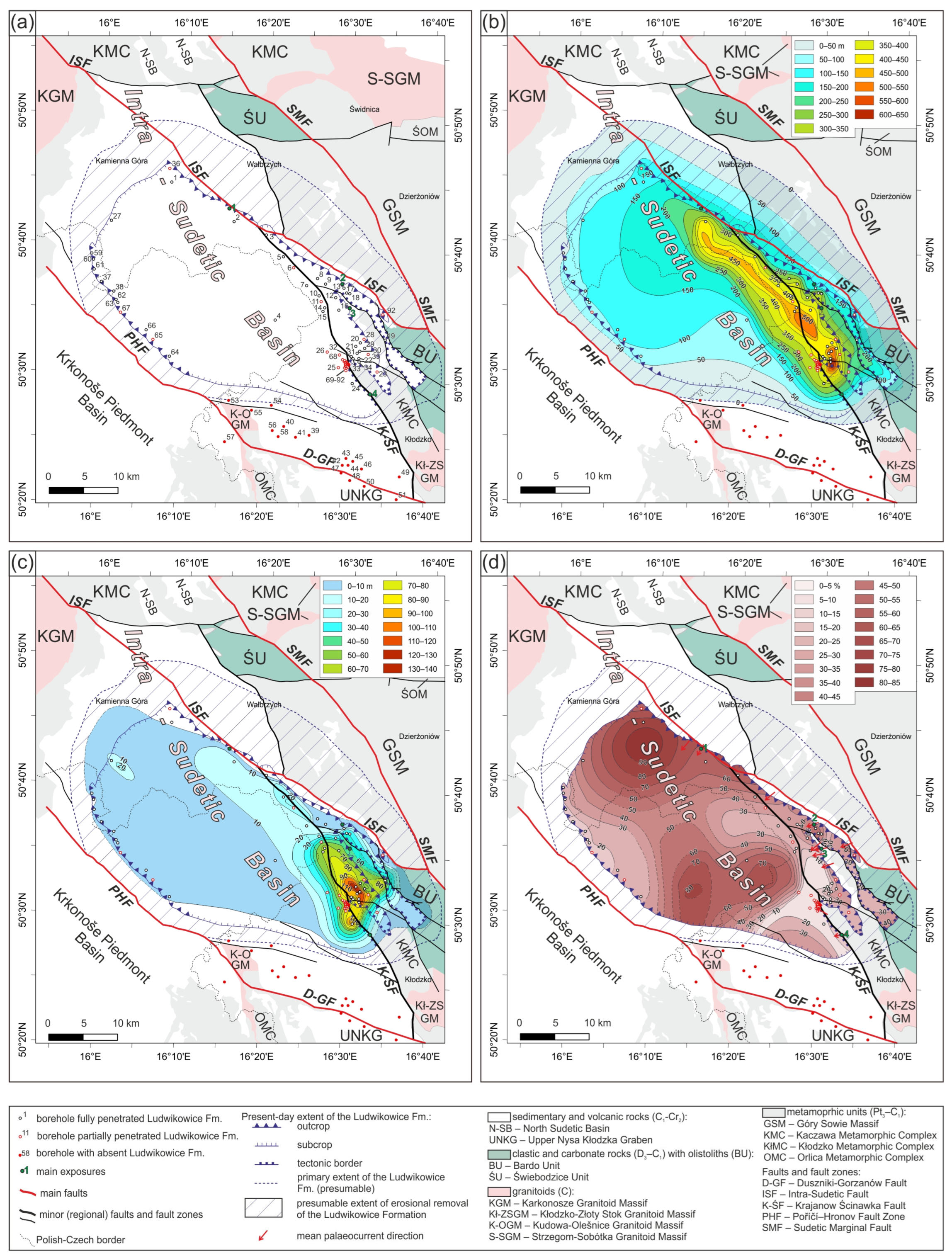
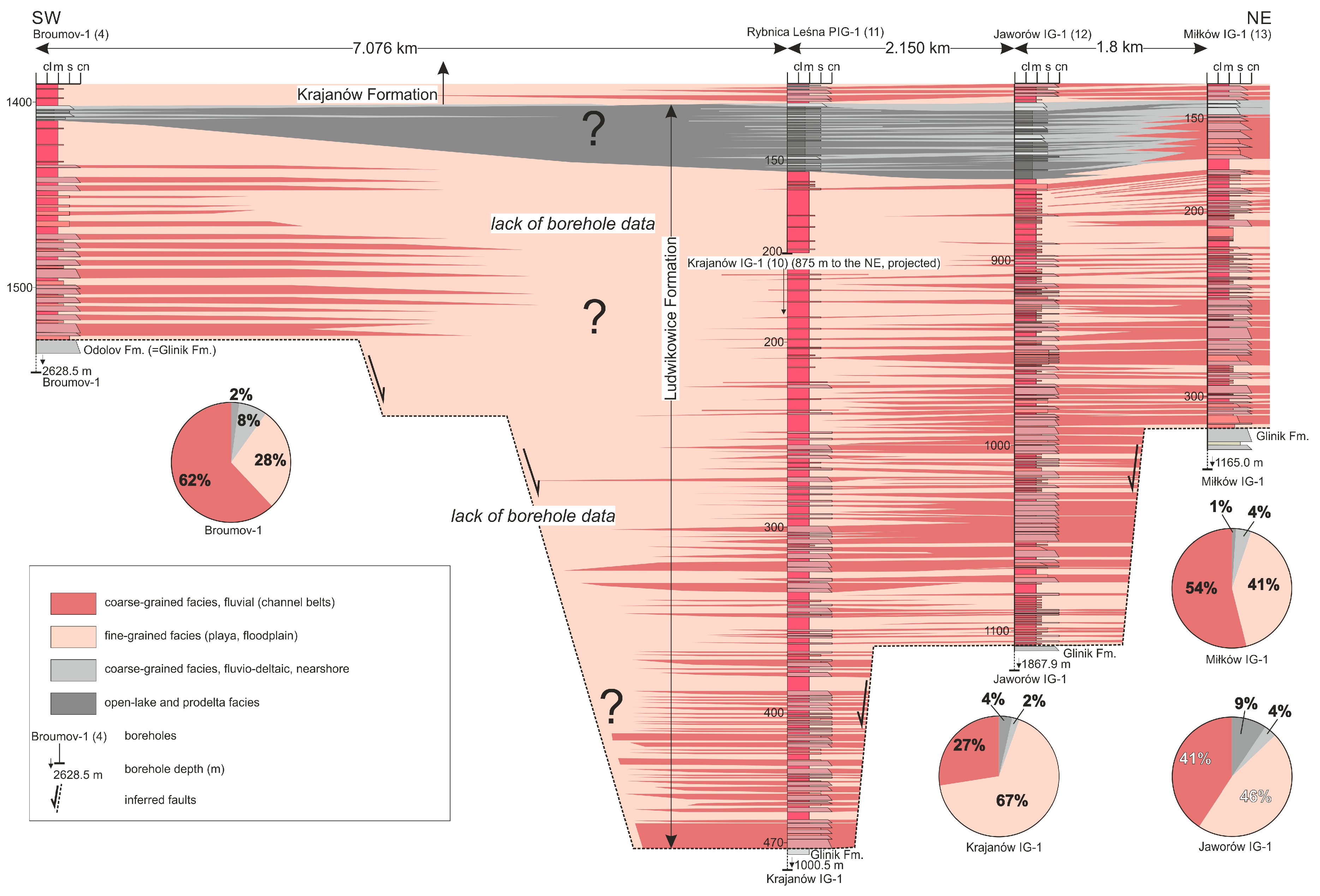
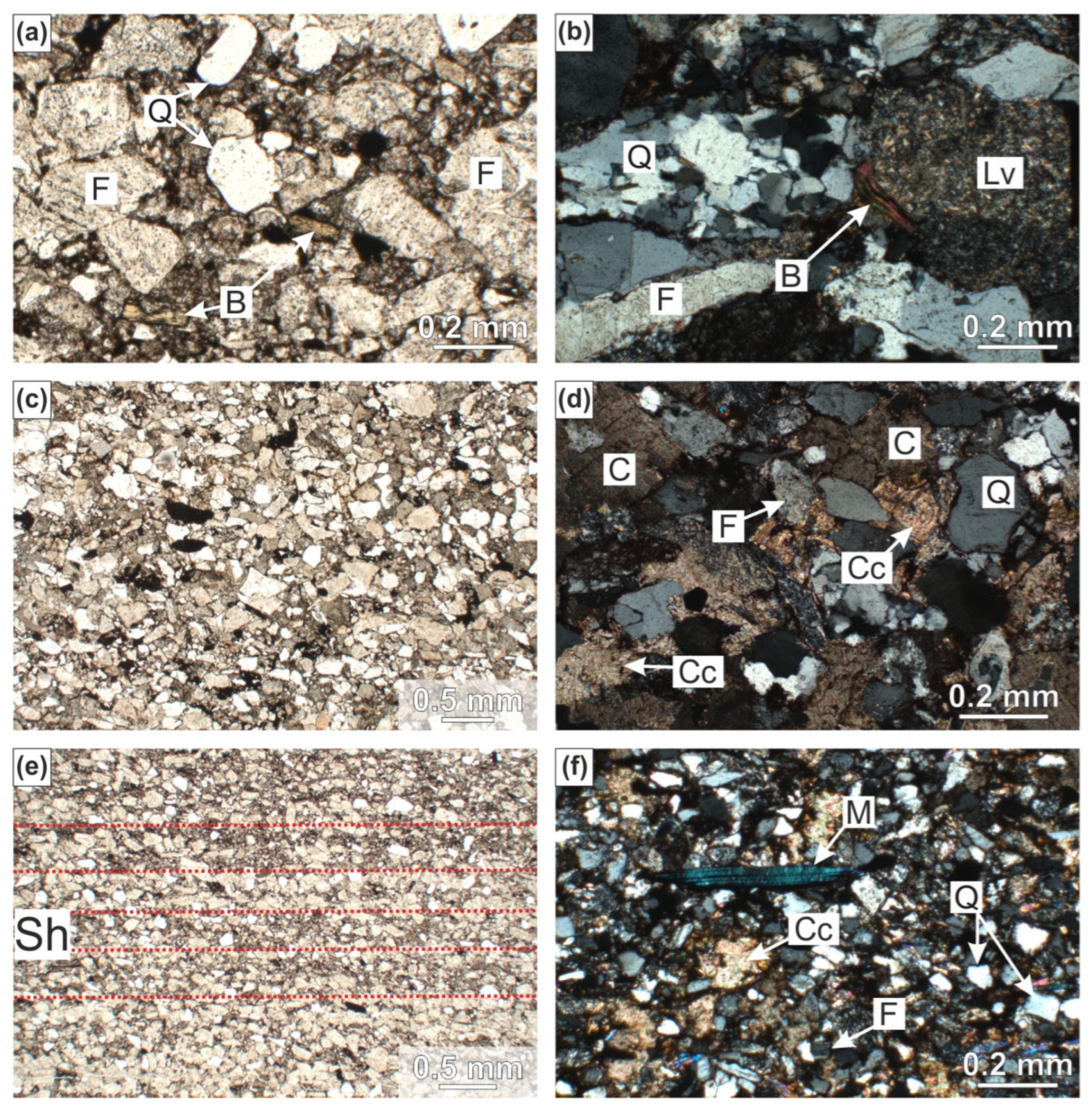


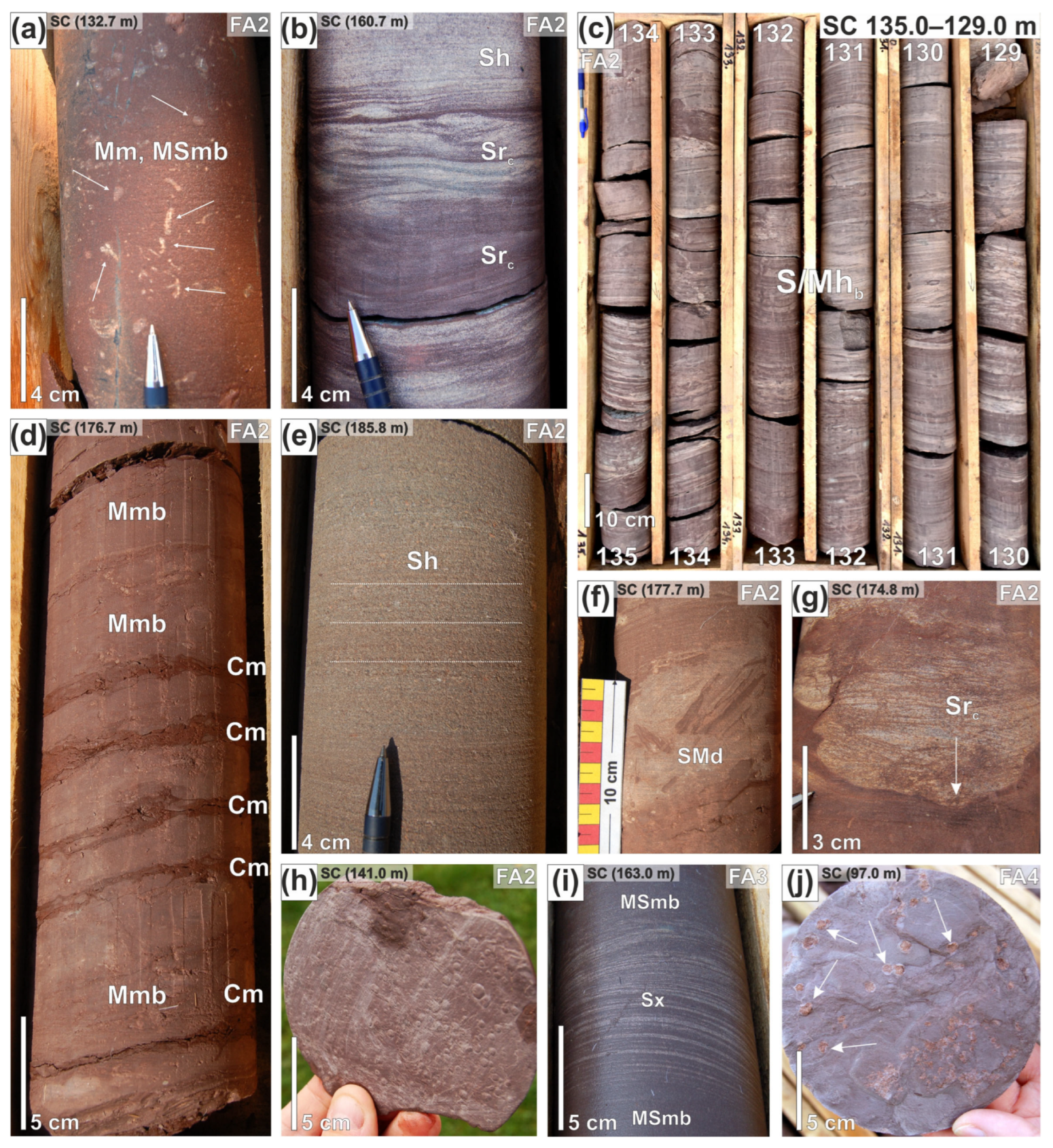
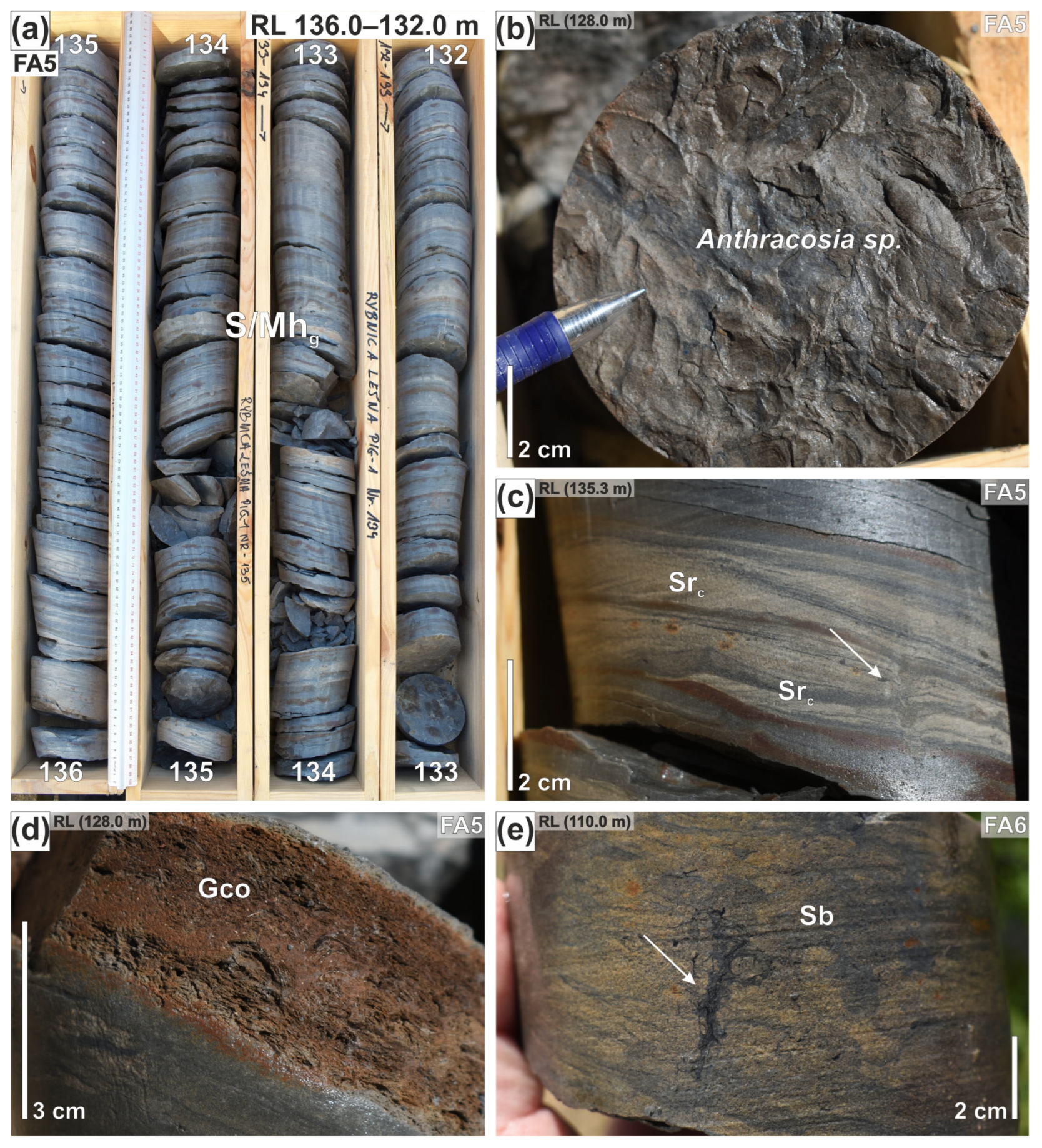
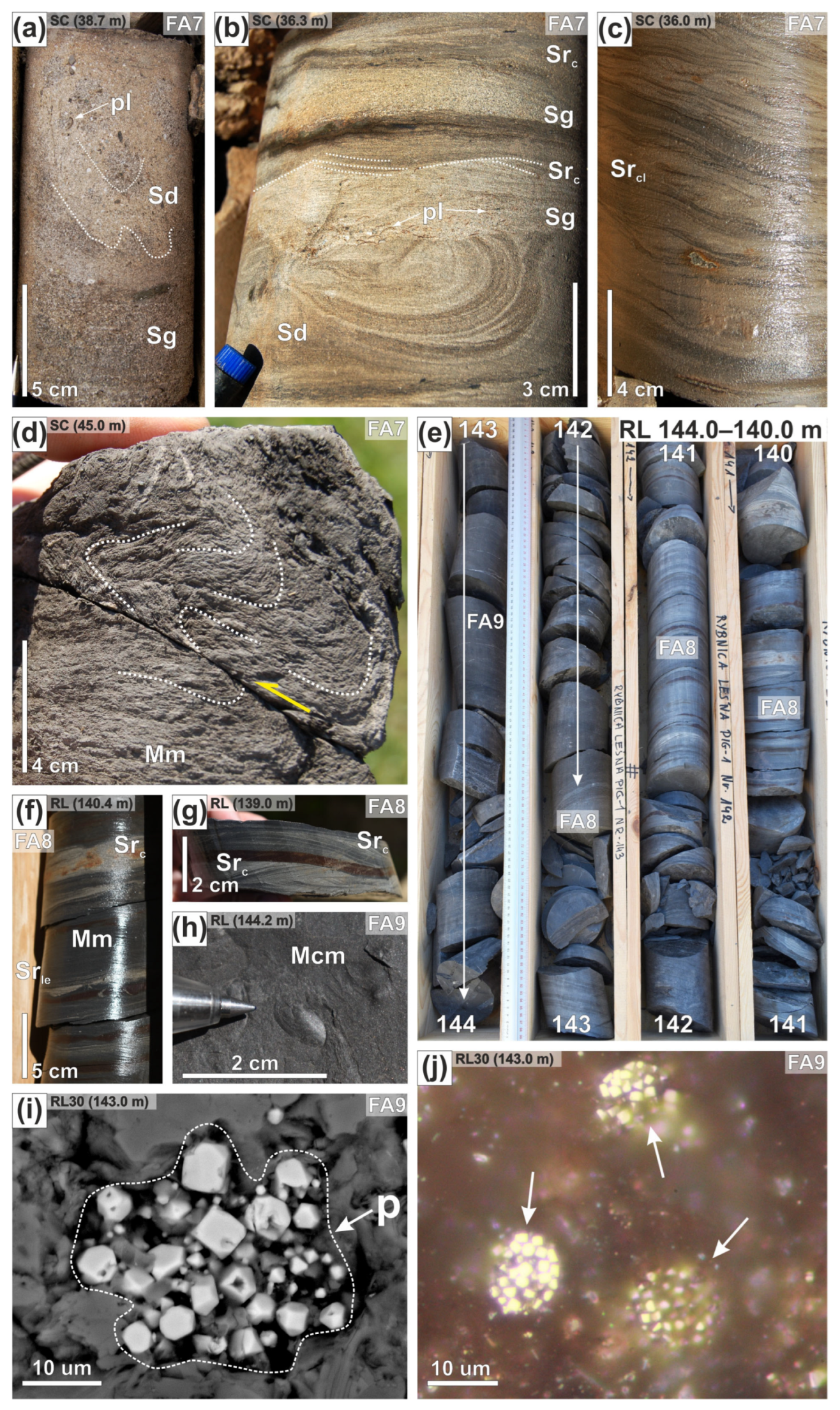
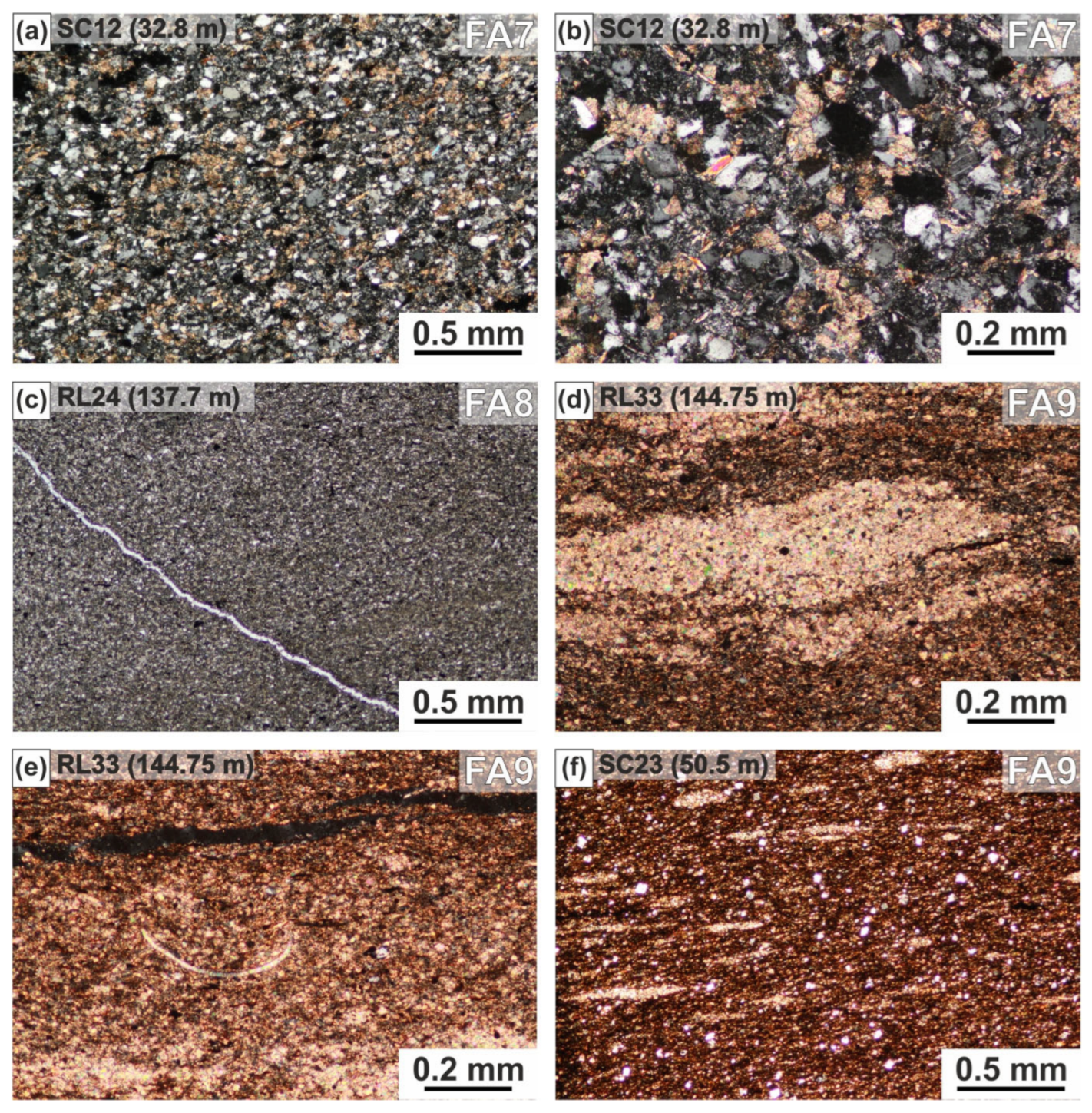
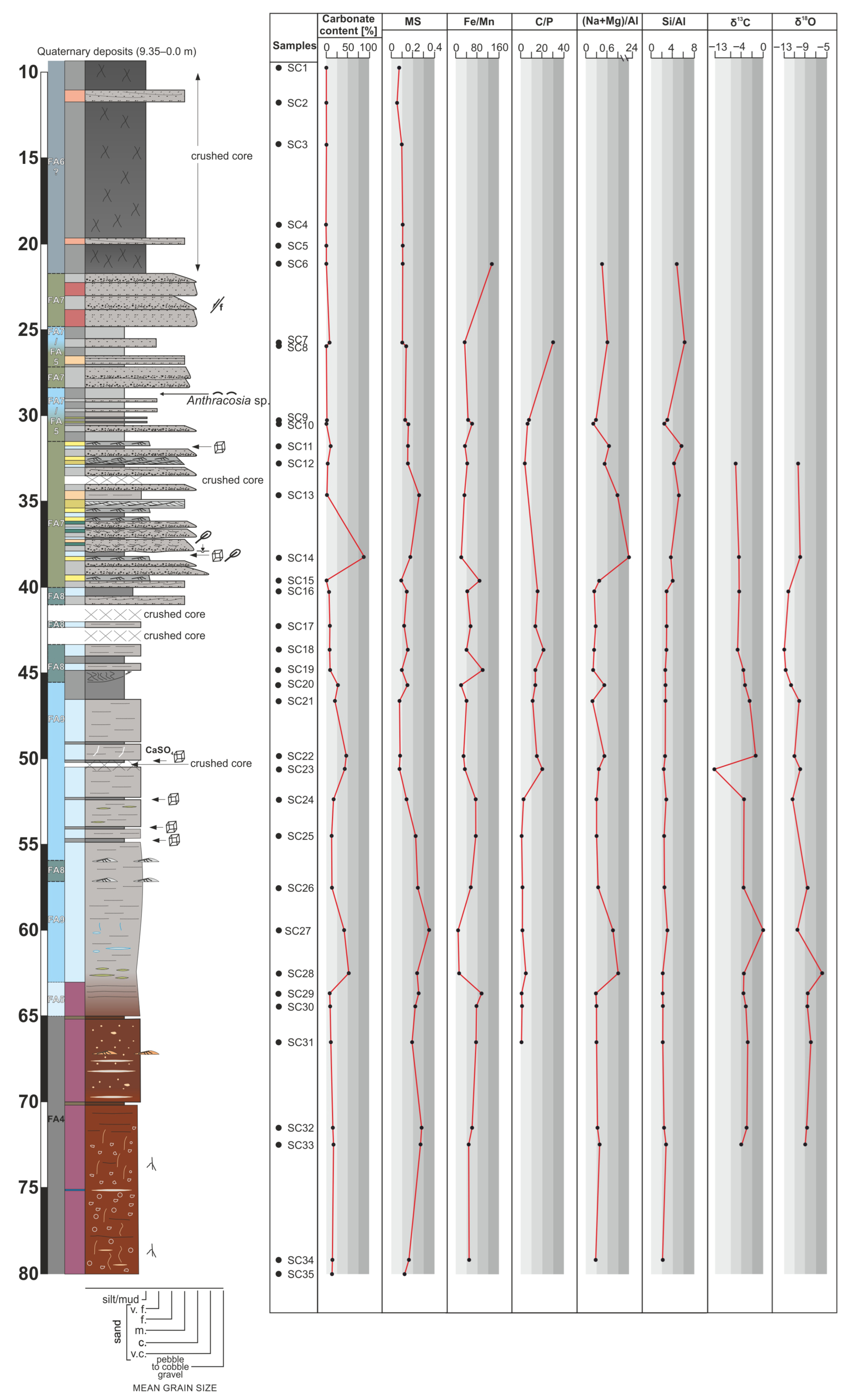

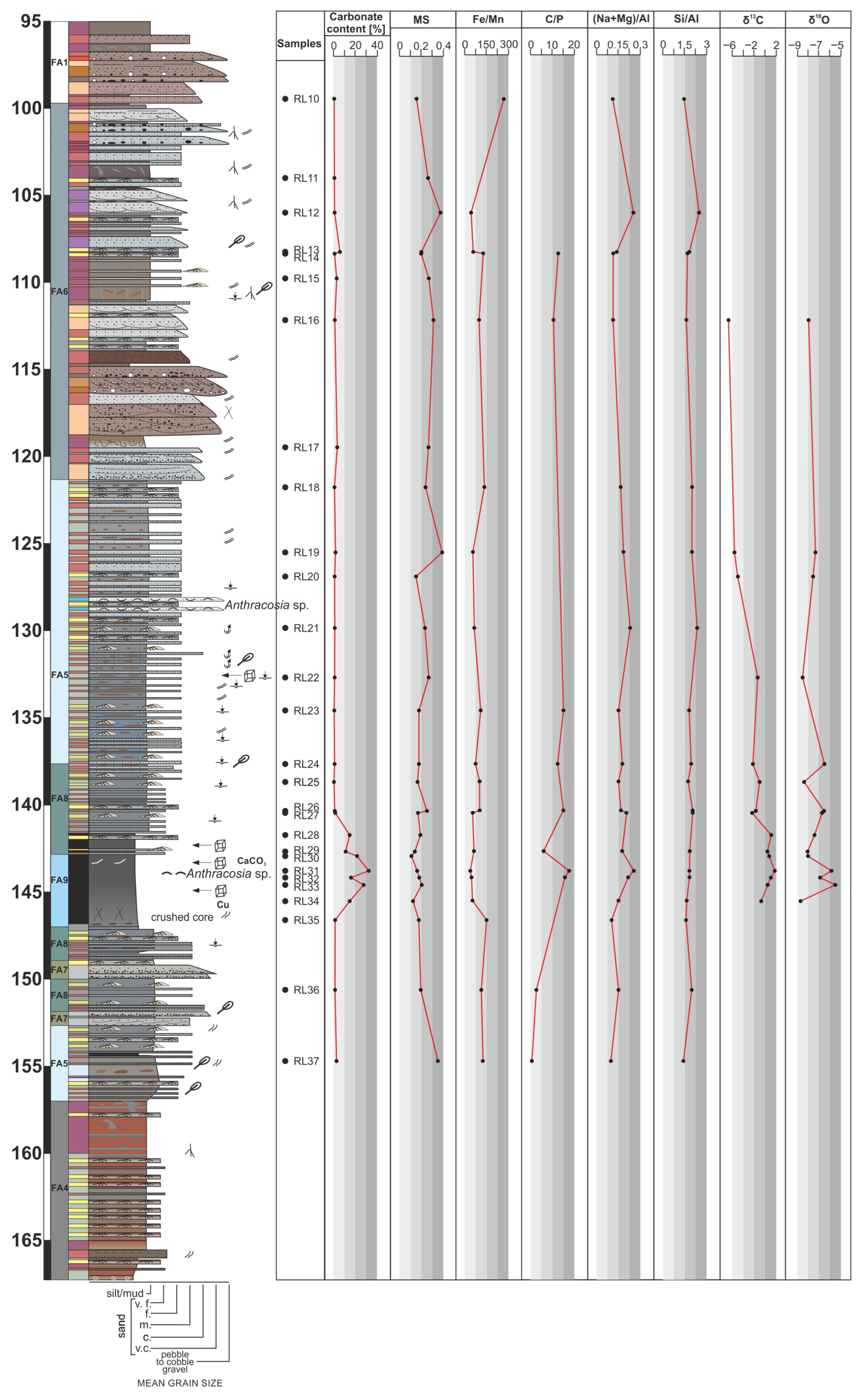
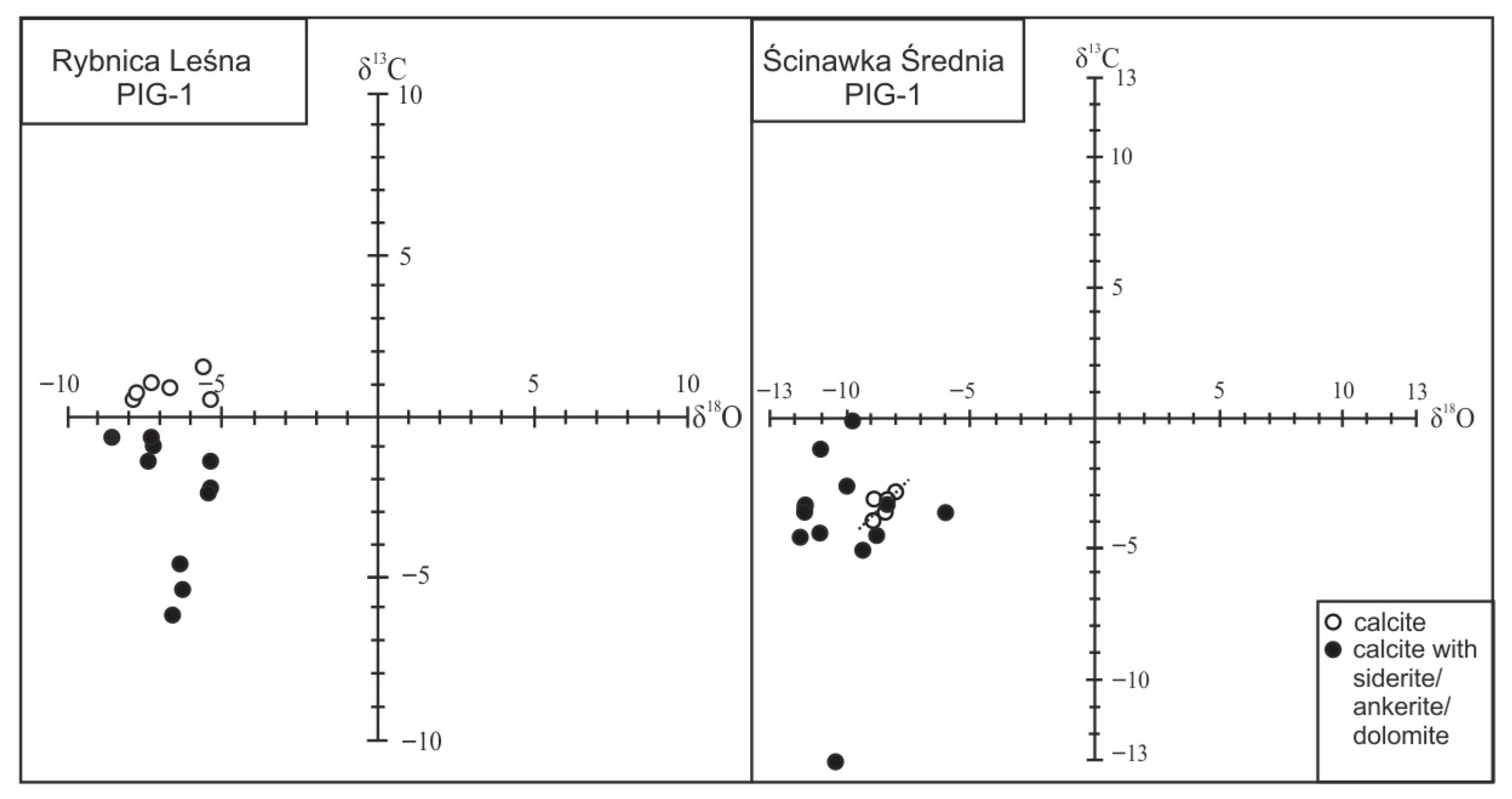

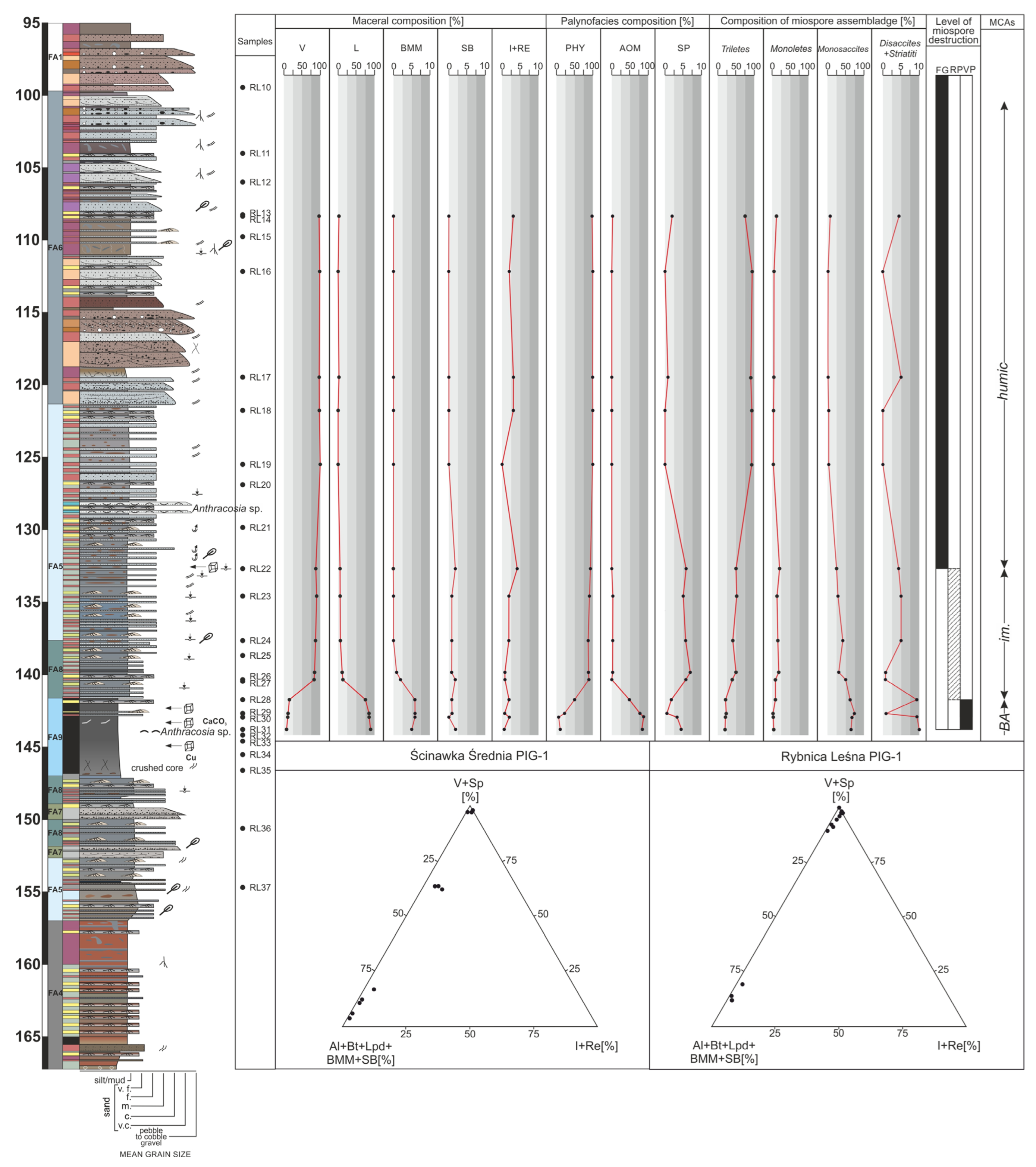
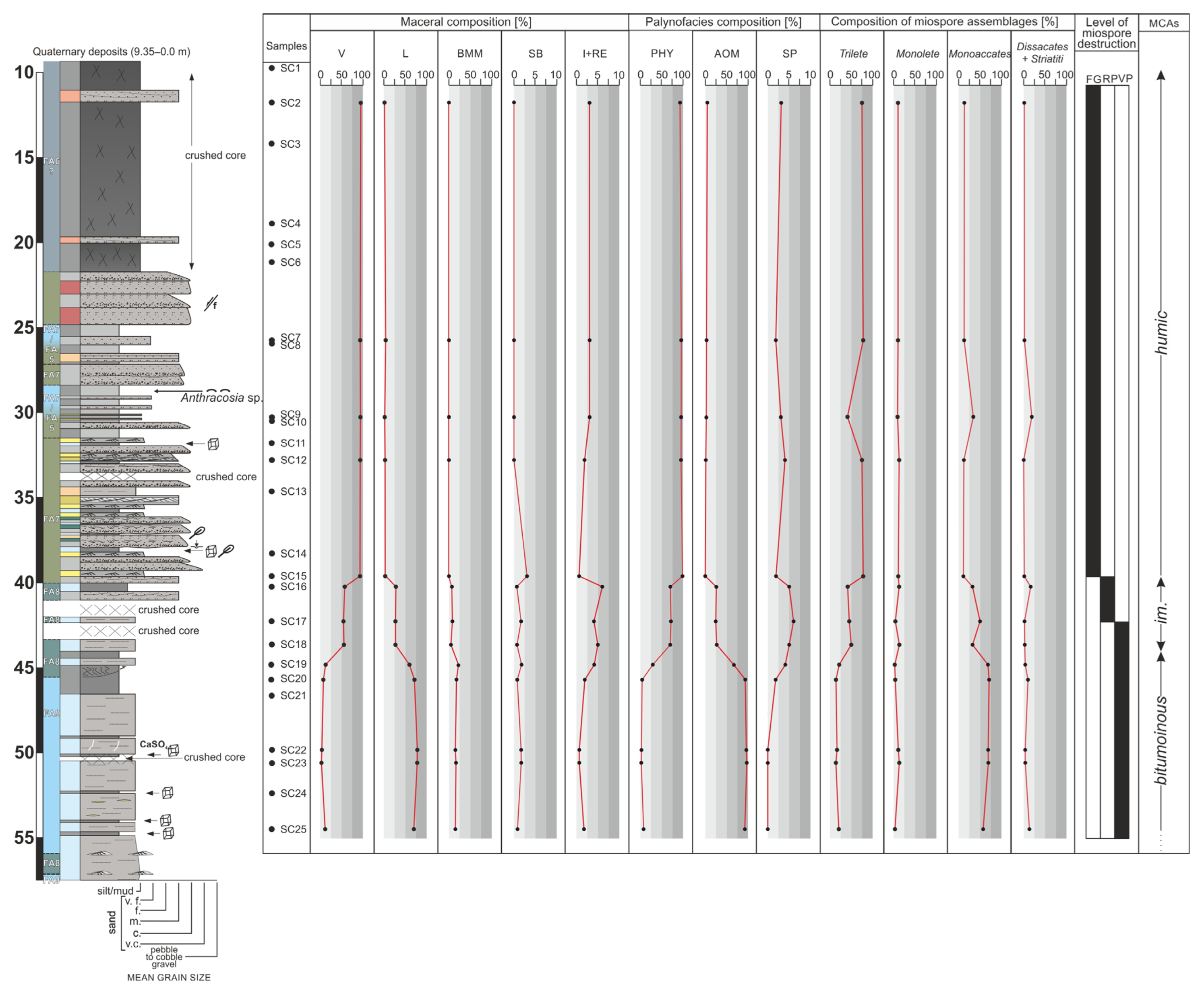
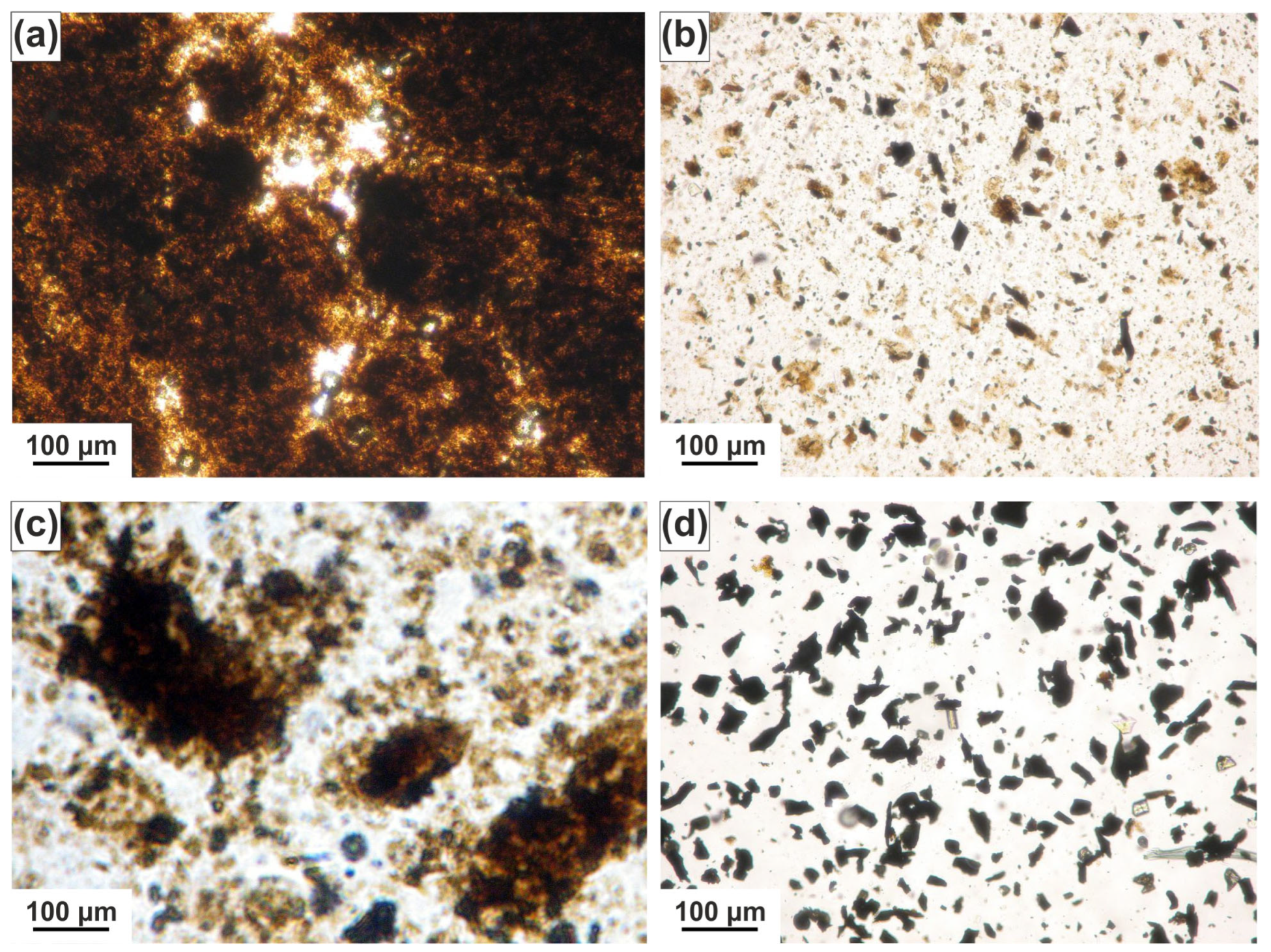
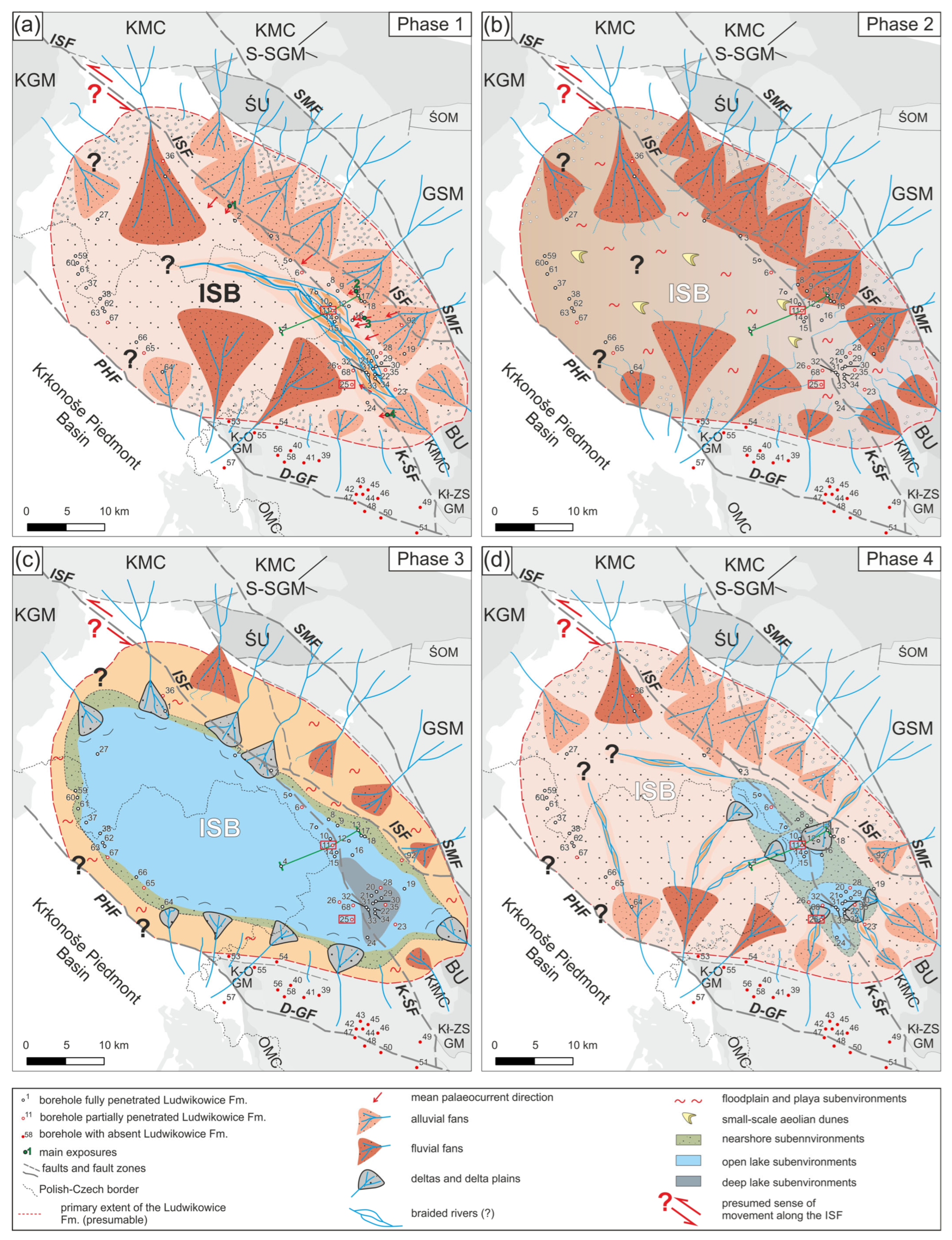
| Lithofacies | Description | Other Sedimentary Features | Interpretation | Facies Associations |
|---|---|---|---|---|
| Gcm Gh GSh | Clast-supported conglomerates ranging from structureless, massive (Gcm) to crudely horizontally bedded conglomerates (Gh) and sandy conglomerates (GSh); bed thickness from one clast to <0.4 m | Imbrication and pebble lineation in lower bed parts (a (t) b (i) fabric); concave-up erosional bases (Gcm); crude horizontal bedding and scattered brownish mudstone/sandstone intraclasts (Gh/GSh) | Deposits of basal, aggradational parts of fluvial channels and channel-floor lags; formed under strong, erosive flows with sediment bypass; diffuse gravel sheets and small-scale longitudinal gravel bedforms. | FA1 |
| Gcg | Clast-supported conglomerates with normal grading; bed thickness < 0.3 m | Normal grain-size grading; sharp and erosional lower contact of beds | Channel or bar deposits formed by rapid flow deceleration. Lower parts of gravel bedforms. | FA1 |
| Gmm | Matrix-supported, massive (structureless) conglomerates; beds 0.05 to 0.3 m thick; clasts embedded in a medium- to coarse-grained sandstone matrix | Structureless; non-erosional, sharp bed boundaries | Deposits of high-strength debris flows, formed under support from pore fluid pressure, and/or dispersive pressure. Gravity flow sheets and lobes in alluvial channels (FA1) or high-density turbidity current/grain flow deposits on subaqueous delta slopes within lacustrine setting (FA7). | FA1 FA7 |
| Gmg | Matrix-supported, normally to inversely graded conglomerates | Non-erosional bases, lack of internal structure | Deposits of waning cohesive debris flows or transitional flows; formed as lobes in alluvial abandoned channels and overbank (FA1) or as high-density turbidity current/grain flow deposits on subaqueous delta slopes within lacustrine setting (FA7). | FA1 FA7 |
| Gco | Coquina beds; thickness < 5 cm | Continuous lags or clusters of shell debris (observed at core scale); sharp, undulating erosional surfaces; accumulations of Anthracosia sp. coquinas | Storm-generated lags developed under strong erosion and winnowing of sand-sized particles. | FA5 |
| Gp GSp Sp SGp | Conglomerates and sandstones (clast- to matrix-supported); sandstones with scattered granule to pebble-sized clasts and intraclasts (SGp) | Planar (tabular) cross-bedding; inclined graded foresets with reactivation surfaces; pseudo-imbricated pebbles and mudstone/sandstone intraclasts up to 4 cm; bounded by sharp planar erosion surfaces | Deposits of straight-crested, 2D gravelly and sandy dunes formed under lower- to middle-flow regime conditions; mid-channel transverse or linguoid bars, or unit bars accreted under unidirectional subaqueous currents. | FA1 |
| Gt GSt St SGt | Clast- to matrix-supported conglomerates (Gt, GSt) and medium- to coarse-grained sandstones with dispersed granule to pebble-sized clasts (St, SGt) | Trough cross-bedding; lenticular beds 0.2–0.5 m thick with concave-up erosional bases and gradational tops; imbricated clasts in lower parts; pseudo-imbricated pebbles and reactivation surfaces in sandy facies | Deposits of sinuous-crested, 3D gravelly and sandy dunes migrated as mid-channel transverse, linguoid bedforms. Formed under upper limits of the lower flow regime by unidirectional subaqueous currents; typical for braided river environments. | FA1 |
| Sh Sl SGh SGl | Medium- to very coarse-grained sandstones with scattered sub- to well-rounded granule to cobble-sized clasts | Low-angle planar cross-stratified bed sets a few meters wide and up to 1 m thick; foreset dips 3–15° (Sl, SGl), usually <10°; tabular horizontal stratification up to 0.2 m thick (Sh, SGh); laterally extensive with flat or irregular, non-erosional boundaries | Deposits of plane-bed transport under upper flow regime conditions during flash floods or rapid flow pulses; washed-out dunes and/or antidunes (Sl, SGl), and sheet-like sandy bedforms (Sh, SGh) (FA1, FA2). In lacustrine setting formed by winnowing and/or high-rate sediment fallout from bedload traction currents or surging HDTC (high-density turbidity currents) (FA7). | FA1 FA2 FA7 |
| Sx | Medium- to coarse-grained, very well-sorted sandstone; quartz-rich; pale yellow to reddish; single granules | Pinstripe lamination: closely spaced, sub-millimeter planar laminations; horizontal to gently inclined; visible over centimeter to decimeter scale in core; locally diffuse or rhythmic | Aeolian wind-ripple strata or sands sheets deposited in interdune flats (?) or on dune flanks; formed under low-energy, unidirectional wind conditions. | FA4 |
| Sg | Fine- to coarse-grained graded sandstone; sporadic granules and scattered small clasts present | Normal or inverse grading; beds with sharp basal contacts; typically massive or faintly stratified | Deposits of sandy debris flows or high-density turbidity currents on delta slopes or subaqueous fans (FA7); reflect en masse sediment freezing or rapid deposition from turbulent suspension. | FA7 FA8 |
| Sd | Fine- to coarse-grained sandstone; poorly sorted; originated probably from graded sandstones (Sg) | Deformed bedding; load casts, flame structures, convolute lamination, slumps; internal disruption of primary stratification; may occur as discrete zones or entire beds | Soft-sediment deformation of Sg and Sm due to rapid loading, water escape, or slope instability. Formed shortly after deposition due to liquefaction and/or gravitational collapse. Often associated with high sedimentation rates and/or seismic triggers (?). | FA7 |
| Sm | Medium- to coarse-grained sandstone with scattered sub-rounded and well-rounded granule to pebble-size clasts | Medium- to large-scale lenticular geometry; lateral extent up to 2 m and thickness 0.2–0.4 m; lacks internal structure | Deposits formed by sudden discharge of sediment-laden flow; interpreted as rapid fallout from traction carpet or collapse of subaqueous sandy bedforms; indicative for upper-flow regime conditions (FA1). | FA1 FA7 |
| Sb | Fine- to medium-grained sandstone; well to poorly sorted | Strong bioturbation—root-related or due to infaunal burrowing; original sedimentary structures commonly obliterated or strongly overprinted | Deposits of low-energy environments with prolonged or repeated exposure to colonization by plants and invertebrates; commonly associated with floodplains, levees, or shallow lacustrine margins subject to intermittent inundation and subaerial exposure. | FA2 FA4 FA5 FA6 |
| Src | Very fine- to medium-grained, well-sorted sandstone | Asymmetrical ripple cross-lamination with undulatory or linguoid ripple forms; cross-laminated sets 2–6 cm thick; laminae often accentuated by silt drapes; load casts occasionally present at bases | Deposits of subaqueous ripple migration under low-velocity (<1 m/s), unidirectional flows; formed in the lowermost part of the lower flow regime. Common in a wide range of depositional settings across fluvial and muddy floodplain environments (FA1, FA2); also in transitional to lacustrine environments (FA5–FA9). | FA1 FA2 FA5–FA9 |
| Srcl | Fine- to medium-grained, well-sorted sandstone | Climbing ripple cross-lamination; typically low-angle with upward migration of ripple crests | Deposits formed by rapid fallout from sediment-laden flows with high suspended load; indicative of low-velocity, unidirectional current and high sedimentation rate; commonly associated with flood-related waning flows (FA2) and high-density turbidity currents on delta slopes or subaqueous fans (FA7) in lacustrine setting. | FA2 FA7 |
| Srle | Fine- to medium-grained, well-sorted sandstone or silty sandstone | Flaser to lenticular bedding; sets are laterally discontinuous, pinch-and-swell geometry; commonly irregular laminae thickness | Deposits formed under low-energy, variable-flow conditions; likely associated with alternating weak currents and slack water phases. Typical of periodically inundated muddy floodplain (FA2), lacustrine nearshore (FA5), and distal prodelta settings (FA8). | FA2 FA5 FA8 |
| S/Mhb | Brown to reddish interbedded fine-grained sandstone and mudstone (heterolithics); sharp or gradational contacts; often mottled or variegated in color | Strong bioturbation; pedogenic features: root traces, slickensides, carbonate nodules and nearly continuous horizons, mottling, or faint lamination; may include weak paleosol horizons. Shrinkage cracks and raindrop imprints | Deposits of intermittently flooded floodplain or abandoned channel fills subject to periods of exposure; modified by soil formation and biological activity; indicative of low-energy, subaerially influenced fluvial environments. | FA2 |
| S/Mhg | Green to grey interbedded fine-grained sandstone and mudstone (heterolithics); well-sorted; typically micaceous | Laminated and heterolithic deposits, ripple cross-lamination; bioturbation and escape structures; bedding contacts sharp to gradational | Subaqueous nearshore lacustrine deposits (FA5); reflect alternating fine sand and mud sedimentation in shallow water below and above wave base. | FA5 |
| SMd | Deformed interbedded mudstones and very fine- to fine-grained sandstones; reddish to brownish in color | Slump folds, flame structures, dish-and-pillar features, convolute lamination; loss of primary bedding; sharp or irregular internal boundaries; occurs as isolated deformation zones within floodplain deposits. | Soft-sediment deformation of heterolithic floodplain deposits triggered by rapid sediment loading, fluid overpressure, or seismic activity. Represents in situ liquefaction or slump features formed shortly after deposition during early compaction or minor syndepositional disturbance. | FA2 |
| Mm Mmb MSmb | Dark brown to reddish-brown massive (Mm) and bioturbated mudstones (Mmb) with sporadic intercalations of very fine- to fine grained, red-pinkish sandstone (MSm) | Massive structure or weak horizontal lamination in sandy mudstones; discontinuous lenses and sheets; strong bioturbation and pedogenic features (root traces, slickensides, carbonate nodules, mottling) | Deposits formed by suspension fallout in floodplain depressions, ephemeral ponds, or abandoned channels, followed by drying, bioturbation (infaunal and root-related), and pedogenesis. Indicative of low-energy floodplain environments (FA2) affected by alternating aquatic deposition and subaerial modification. | FA2 |
| Mm (c) Mh (c) | Grey calcareous mudstones; massive (Mm) or slightly heterolithic; carbonate-rich | Structureless to faint horizontal lamination; interbedded with thin silty or fine sandy layers in heterolithic varieties; may show weak bioturbation or burrow mottling | Deposits formed under low-energy, suspension-dominated conditions with carbonate input; typical of shallow lacustrine settings influenced by both clastic and carbonate sedimentation. | FA8 |
| Mm (g) | Grey mudstones; massive or slightly heterolithic, predominantly non-calcareous | Structureless to faintly laminated; locally bioturbated with root traces, mottling, and dispersed plant detritus | Deposits formed by suspension fallout in low-energy, distal overbank or delta plain environments situated between distributary channels. Periodic subaerial exposure promoted root bioturbation and minor soil formation; the presence of organic matter reflects intermittent vegetation cover and waterlogged conditions. | FA6 FA8 FA9 |
| MCm | Dark grey to black, fissile, clayey mudstones; rich in organic matter; commonly slightly laminated. | horizontal lamination or fissility; absence of bioturbation; occasional plant debris; may contain pyrite framboids or other diagenetic minerals | Deposits formed under low-energy, anoxic to dysoxic conditions in stagnant water bodies with high organic productivity and minimal bottom current activity. | FA8 FA9 |
| Cm | Brown claystones; a few cm thick | Massive structure or faint horizontal lamination; occasional mottling; enriched in calcium carbonate, either dispersed or as incipient mm-scale nodules | Suspension fallout deposits resulted from waning overbank floodwaters, followed by periods of subaerial exposure and incipient pedogenesis. | FA2 FA4 |
Disclaimer/Publisher’s Note: The statements, opinions and data contained in all publications are solely those of the individual author(s) and contributor(s) and not of MDPI and/or the editor(s). MDPI and/or the editor(s) disclaim responsibility for any injury to people or property resulting from any ideas, methods, instructions or products referred to in the content. |
© 2025 by the authors. Licensee MDPI, Basel, Switzerland. This article is an open access article distributed under the terms and conditions of the Creative Commons Attribution (CC BY) license (https://creativecommons.org/licenses/by/4.0/).
Share and Cite
Kowalski, A.; Dąbek-Głowacka, J.; Nowak, G.J.; Górecka-Nowak, A.; Wyrwalska, U.; Furca, M.; Wójcik-Tabol, P. Evolution of a Late Carboniferous Fluvio-Lacustrine System in an Endorheic Basin: Multiproxy Insights from the Ludwikowice Formation, Intra-Sudetic Basin (SW Poland, NE Bohemian Massif). Minerals 2025, 15, 1077. https://doi.org/10.3390/min15101077
Kowalski A, Dąbek-Głowacka J, Nowak GJ, Górecka-Nowak A, Wyrwalska U, Furca M, Wójcik-Tabol P. Evolution of a Late Carboniferous Fluvio-Lacustrine System in an Endorheic Basin: Multiproxy Insights from the Ludwikowice Formation, Intra-Sudetic Basin (SW Poland, NE Bohemian Massif). Minerals. 2025; 15(10):1077. https://doi.org/10.3390/min15101077
Chicago/Turabian StyleKowalski, Aleksander, Jolanta Dąbek-Głowacka, Grzegorz J. Nowak, Anna Górecka-Nowak, Urszula Wyrwalska, Magdalena Furca, and Patrycja Wójcik-Tabol. 2025. "Evolution of a Late Carboniferous Fluvio-Lacustrine System in an Endorheic Basin: Multiproxy Insights from the Ludwikowice Formation, Intra-Sudetic Basin (SW Poland, NE Bohemian Massif)" Minerals 15, no. 10: 1077. https://doi.org/10.3390/min15101077
APA StyleKowalski, A., Dąbek-Głowacka, J., Nowak, G. J., Górecka-Nowak, A., Wyrwalska, U., Furca, M., & Wójcik-Tabol, P. (2025). Evolution of a Late Carboniferous Fluvio-Lacustrine System in an Endorheic Basin: Multiproxy Insights from the Ludwikowice Formation, Intra-Sudetic Basin (SW Poland, NE Bohemian Massif). Minerals, 15(10), 1077. https://doi.org/10.3390/min15101077






